Posts Tagged ‘Holocaust fraud’
Saturday, October 2nd, 2021
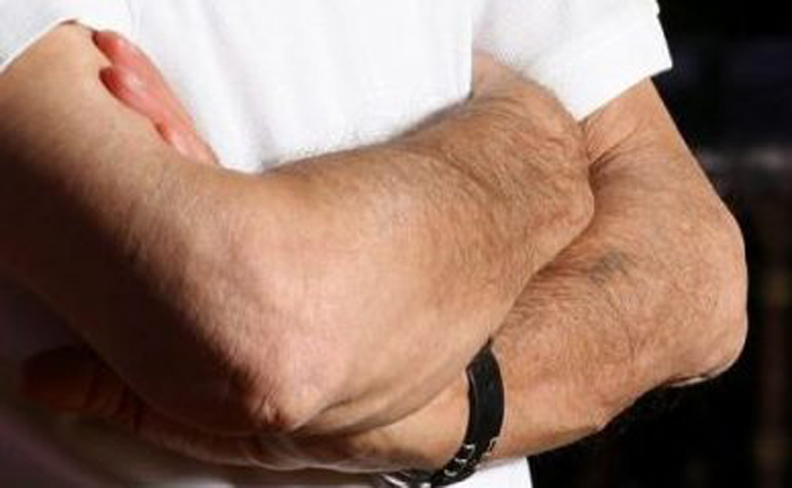
Close-up of Wiesel’s arms from the photograph taken in 2006 by Eyal Toueg, published after Elie Wiesel’s death.
By Carolyn Yeager
It’s been five years now since Elie Wiesel died and his body was buried in a plain pine coffin.
This website premiered in July 2010 with the question: “Where’s the tattoo?” No one had ever seen it, yet Wiesel claimed to have it as proof he was an inmate at Auschwitz in 1944. Please refer to “Where is Elie’s tattoo?” before you read further.
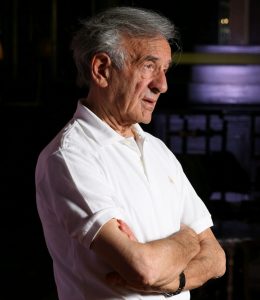
The full image as published in Haaretz a week after Wiesel’s death in July 2016.
In seven years, this site had learned and published a great deal [over 130 articles] about Elie Wiesel’s life events and the incredible trail of lies he left in his wake. But we had still not seen the tattoo! That is, until the above photo was published by Haaretz, a leading Israeli newspaper, a week after his death. Behold! the distinctive appearance of a bluish smudge on ElieWiesel’s bare left forearm. The photo, said to be taken in Israel in 2006 by Eyal Toueg, is high-resolution and gives every appearance of being an authentic representation of Wiesel at that time—in other words, not photo-shopped. Haaretz is a generally reliable source with a reputation to protect. Since then, I’ve seen no further mention of the photograph.
My takeaway on what we see there is that it is clearly NOT the number A-7713, which is what Wiesel claimed all his adult life he had. He lied—and got away with it. Please see my articles “How Wiesel’s ‘tattoo’ looks from where I’m sitting” and “New (old) pictures come to light in wake of Elie Wiesel’s death” for my impressions in 2016.
Five years later I can say with confidence that whatever it was that may have been on his arm and appears to have possibly been removed was never the number A-7713. (Why? Because it it were A-7713, it would not have been removed while he was still claiming it was there.)
“Appears to have been” is the key here because we’re dealing solely with appearances. We have no statements from Wiesel’s intimates and allies about the tattoo. When it comes to questions about that, they are mute. We also have other images of Wiesel’s bare arm with nothing appearing there or with what could be a faint trace of a number (see below). However, no matter how much these “faint traces” are enlarged, no number can be made out—it is seen to be only a ‘shadow’ on the arm.
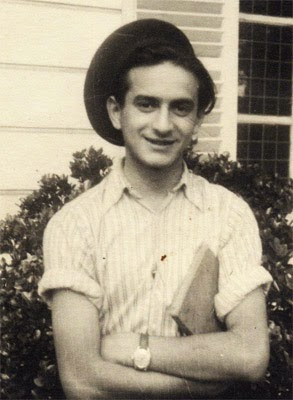
Elie Wiesel in Ambloy, France in 1945 with mark on arm that disappears into nothing when enlarged.
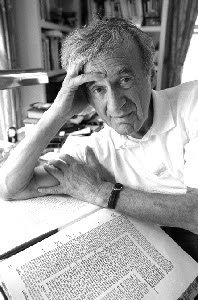
This photo taken on the same day as the one above in 2006. Wiesel is wearing the same shirt and his wristwatch is facing down. But the faint mark on his arm doesn’t match the image above.
The explanation for these last two photos, one taken in 1945 and the other on the same day in 2006 he was wearing the white knit shirt, is that they were both uploaded to the Internet by Loupi Smith and no one else! Neither of these images are found in the U.S. Holocaust Memorial Museum collection, the Auschwitz-Birkenau Museum, or even at Yad Vashem. If they were proof that Elie had a tattoo, wouldn’t they be there?
Loupi Smith is a notorious French Jew who’s long been engaged in battle with revisionists (known as negationists in France), most especially with the honorable Vincent Reynouard. It’s most likely that Smith took images of Wiesel without any mark on the arm and applied the desired effect directly to the photographic print he had obtained. He then uploaded these to the Internet and waited for them to be found, or had friends/agents who “found” them.
As to why Haaretz decided to publish this photo right after Wiesel’s death, Haaretz will have to answer that. We are not mind-readers and have to depend largely on honesty from the parties involved, but honesty has never been forthcoming from Holocaust advocates. For example, see my articles about AP reporter Verena Dobnik who in Nov. 2012 wrote that Wiesel showed her his Auschwitz tattoo by “pulling back his left jacket sleeve” during an interview she was conducting with him. Of course, she didn’t and never would say what it was, just that it was an “Auschwitz tattoo.” See “AP reporter doesn’t reply to questions about seeing tattoo on Elie Wiesel’s arm” and “AP stonewalling legitimate questions about reporter seeing Elie Wiesel’s tattoo.” Nothing unusual here, though—it’s the usual behavior from all media and government sources when it comes to anything “holocaust.”
FINAL CONCLUSION: Elie Wiesel lied about his tattoo. All the feeble explanations/excuses put forward by his supporters and fans for why he refused to show it are inadequate in the face of the proofs we’ve assembled. Wiesel stole the identity of Lazar Wiesel, who was 13 years his senior and who was recorded as being an inmate at Auschwitz-Birkenau (tattooed with A-7713) and at Buchenwald camps in 1944-45. No records for a 16 or 17 year old Eliezer Wiesel born in 1928 exist at either camp.
If he lied about the tattoo, it is certainly believable he lied about being in Auschwitz and Buchenwald. In support of that possibility are the facts that his stories and descriptions don’t match the well-known reality of the camps; his timelines are off; people who were known to be there at the same time he was, even housed in the same buildings, never mentioned seeing him—either before or after he became famous. All this and more is documented at this site.
Elie Wiesel’s “Idea”
Equally important to Elie’s lack of the claimed tattoo is, in my opinion, his admitted twisting of what it means to be a witness. There are two parts to his approach: 1) What happened may not be “true” and what is the “truth” may not have actually happened, and 2) Every Jew should be a witness to the Holocaust regardless of whether they actually participated. Part 2 is made possible by part 1.
Wiesel announced his willingness to deceive in several of his books, and in interviews. Even though he told us exactly what he was doing, it seems no one wanted to take it seriously. The sainthood of Elie Wiesel was too appealing.
 Of his several statements, covered in my article “Elie admits his true stories never happened,” I think the most compelling was in a 1970 interview with Gilles Laponge, published in the book Elie Wiesel: Conversations (2002). You can find the interview online HERE at Google Books. Wiesel said:
Of his several statements, covered in my article “Elie admits his true stories never happened,” I think the most compelling was in a 1970 interview with Gilles Laponge, published in the book Elie Wiesel: Conversations (2002). You can find the interview online HERE at Google Books. Wiesel said:
In [my] book “One Generation After” there is a sentence which perhaps explains my idea: “Certain events happen, but they are not true. Others, on the other hand, are, but they never happen.” So! I undergo certain events and, starting from my experience, I describe incidents which may or may not have happened, but which are true. I do believe that it is very important that there be witnesses always and everywhere.
[…]
The people of my generation are, in various ways, all survivors. We must prevent the Holocaust from being erased from the memory of the world.
He’s telling us he’s writing fiction “based on his experience” but insisting it’s ‘true’, and even 100% true. What is the basis of his experience? Being a Jew. A Zionist Jew. Wiesel’s life history of being a Hasidic Jew is primary in his experience, according to his own words. This means he accepts the following and has said so:
- Belief taking precedence over Reality;
- Religion over History;
- Storytelling over fact-finding;
- Hearsay over first-person evidence; and
- Feelings over Justice.
In other words, it’s Ashkenazi Jewish mysticism vs European Christian Law. It’s interesting to note that at Boston University, where Wiesel had a cushy “professorship” for many years, he taught in the Religion and Philosophy Departments, not the History Department. See my article on BU here.
A little further in the interview Wiesel continues with the cloudy language:
“I believe in a way we are all culpable even though the guilt of the torturer is not that of the witness or the survivor. Do not see in my words the least resignation to evil. […] No, evil is absurd the same way the Holocaust is absurd. I remain convinced that this event, the most significant in history, might very well not have happened.”
Everyone can be a survivor, with the important job of preventing the memory of the Holocaust from being lost or “erased.” For this purpose, apparently everything and anything goes. Making things up to be far worse than they actually were is nothing unusual. It’s considered necessary to reinforce the memory.
When Wiesel claims that “every word” in Night “is true,” he’s using a definition of “truth” different from the standard dictionary meaning. When testifying in a court of law, the lawyers and judges should first establish what is his understanding of truth, but they never have.
On this basis, Wiesel received award after award from prestigious Gentile groups, all the way up to the Nobel Peace Prize. Wiesel has indeed conned the world.
We pronounce Elie Wiesel a false witness from beginning to end.
2 Comments
Category Featured | Tags: Tags: Auschwitz tattoos, Elie Wiesel, false witness, Holocaust fraud,
Social Networks: Facebook, Twitter, Google Bookmarks, del.icio.us, StumbleUpon, Digg, Reddit, Posterous.
Sunday, June 26th, 2016
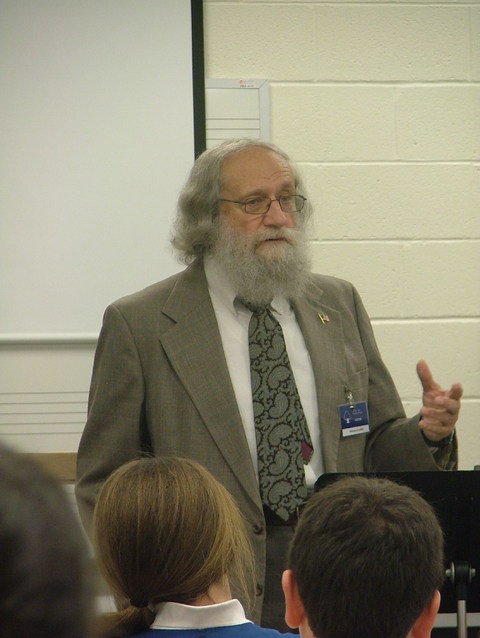
Psychological terrorist Joseph Hirt speaking to 7th grade students (age 13), filling their heads with horrible lies with the blessing of school teachers and administrators. He was never vetted to find out if he was qualified to influence impressionable youth. Shameful carelessness !
BY CAROLYN YEAGER
The mainstream accounts of Joseph Hirt’s “confession” are showing up everywhere, but they mistakenly report it as Hirt “coming clean” about his lies. Not true. Hirt didn’t just lie about being in Auschwitz, he lied about many of his experiences during the “Holocaust” in general, and continues to do so. And really, how can you expect a man who claimed he saw Adolf Hitler turn his back on Jesse Owens at the 1936 Olympics (when he was 6 years old and living in Poland) to be a man you would ever trust to tell the truth? Particularly on this subject. This is only common sense – a universal human trait that has been made illegal in almost all of Europe, and socially condemned everywhere else because it is a threat to the “holy holocost” religion. But common sense is what I will be using in this article to show the pure hatefulness and falsity of the stories Joseph Hirt has been telling Pennsylvania school children for 15 years already.
As I wrote earlier, New York history teacher Andrew Reid did a knock-down, bang-up job in scaring the daylights out of old Joseph Hirt, threatening him with investigations of forgery, fraud and identity theft if he didn’t come clean and admit his Holocost survivor claims were false. After some initial resistance, the cunning 86-year-old realized his game was up and he needed Reid as a friend, not an enemy. Hirt composed a long letter and made it public by sending it to a newspaper. It is now posted at Scribd. for all to read. It’s clear from this letter that he is not sorry for what he did, he is only sorry he was caught and couldn’t wiggle his way out of it with a man of principles like Reid, who did a commendably thorough job. The letter is a combination treatise about the horrors of the Holocost, his personal life story, and a few paragraphs stating he was wrong to “insert himself into the picture” at Auschwitz, but he only had the best of intentions. He asks for forgiveness.
Hirt appears to me as an intelligent, educated man whose self-absorption developed into an obsession with “The Holocaust,” reading many books and surlievor stories about it. His counsel to the 6th through 12th grade students he’s spoken to for so long is to “keep the truth and the memory of the Holocost always in your heart and mind.” Is that good advice? The kind you’d like your children to receive in school? Hirt is convinced he’s turned many into lifetime believers and upholders of the holocost myth, and says that is his goal.
He begins the letter with an overview of what the ‘Holocaust’ was — his own condensed version of the official Jewish narrative — intended to bolster his claim to having the “best of intentions.” His intentions are to prevent it ever happening again … but did it happen the first time? He begins:
The Nazi Holocaust refers to the W.W. II concentration camp system used for the extermination of about six million Jews and about five million non-Jews by Nazi Germany.
False. The camps were not for extermination at all but for separating the perceived disloyal, harmful and or criminal elements from society, just as prisons everywhere. How does he explain that over half a million European Jews received lifetime payments from Germany if the plan was to kill them all? There were the same number of Jews in the world after the war as before – just in different places. Why were Jews still living in Berlin at the end of the war? Did the murderous Nazis forget about them? Why were there millions of displaced persons in Europe after the war? And why was his hero Primo Levi put in the camp hospital at an alleged ‘death camp’, Birkenau, and left there to await the arrival of the Soviets? He could easily have been put to death. There were also 600 or so children in that camp when the Soviets arrived, being well taken care of by Polish women. There is no proof of extermination at all, only assumptions based on a desire to punish Germany and exculpate the Allies.
The killings took place in specially constructed camps, most located in Poland, The victims were herded into cattle cars and transported to the camps. After days on end en route or standing unattended along the way without food, water, or medical care, many died.
Not at all. He can’t just generalize “camps” and make vague references to “days on end”. Transports to Auschwitz-Birkenau were at most two days in length, there was water in the rail cars, they brought their own food, and no one died en route. Many Jews were taken to their destination in passenger cars. Later on, in 1944, available trains were scarce.
On arrival at certain camps the victims were told to undress for showers, but were led instead to rooms where they were gassed to death. Bodies of men, women, and children were removed by specially assigned prisoners whose working units burned them—first in open fires, and later in crematoria built for that purpose.
Really, where is he talking about?! “Certain camps?” He’s afraid to name them lest he can then be proven wrong. “Were gassed to death in rooms” on the pretext of taking a shower? This has been convincingly debunked as atrocity propaganda. Then “burned in open fires.” Did he ever see such a thing? Of course not. No one has. And it doesn’t work either, humans don’t burn that easily. Hirt takes all this from books he has read, books by Jews, every one of them the result of rumors and motives of tribal revenge.
Sometimes inmates were deliberately starved. Those who became weak or ill were sent directly to be gassed. Some were killed in camp hospitals by injection directly into the heart. Others were hanged, beaten, or suffocated in tiny airless cells. Both planned and spontaneous brutality played a role in the treatment of inmates. They were ruled by other inmates, often former criminals imported from actual prisons, who imposed their rule by degradation, mutilation, and torture.
I categorically deny that any inmates were deliberately starved in any German/SS-run camp at any time. There is zero evidence of that except for tales told by surLIEvors, always based on what someone else said, never anything they saw or experienced first hand. Because victims of typhus (and some other diseases ) rapidly lose weight and body tissue, and become “skin and bones,” photographs of these victims have been used to accuse the camp authorities of deliberately starving them. The idea that inmates were kept on a starvation diet is completely false. The same goes for importing criminals from civilian prisons to boss over the camp inmates. The fact is, there were actual lawbreakers in some of the camps because they had been assigned to serve out their prison term there. But partisans and communists were pretty nasty dudes too. Any of the rare hangings that did take place were for cause, after the accused was found guilty of a serious offense. Injections through the heart is a rumor that has never been proven. Other camps were solely industrial labor camps for producing war munitions and other wartime needs, like the Auschwitz complex. I have yet to see any evidence that anyone suffocated in tiny airless cells, and I have studied it and written about it.
Certain camps combined labor and extermination, selecting incoming prisoners for one category or the other; the selections at Auschwitz were infamous. Those deemed capable of work or considered useful in (cruel) experiments were assigned to quarters in the camp. Others were immediately taken to the gas chambers. Families were separated forever in this process.
By describing the Holocost in such amorphous terms and dislocating it from the war, by using photographs doctored in the intelligence laboratories, by having the help of the major media outlets and Hollywood—that is how they succeed in keeping the public believing. (Not to mention indoctrination in schools to unprotected, inexperienced children, with fakers like Joseph Hirt coming to visit regularly.) And sorry, there were no cruel experiments being carried out – not even by Dr. Mengele! It is the writers of the surlievor books who have made “the selections at Auschwitz infamous.” In reality, at that place, those who could not work—all those women with children and elderly people—went to Birkenau with it’s numerous barracks where classes and programs, music and theater productions were available to help them pass the time. Some worked in the kitchens and the medical facilities. There were family sections for gypsies and other groups who were not desirable as workers. No one was exterminated. There were no homicidal gas chambers anywhere in the camp, only buildings for gassing clothing and mattresses.
Information about concentration camp behavior exists because of the sharing of details by a relatively small number of inmates who managed to survive. Soon Holocaust memories will be held entirely by those who were not there!
This is painful for him, the fear that “the Holocaust” will lose its power and influence without real surlievors to talk about it as eye-witnesses. But he admits it’s a small number who have given us these details. Not because the rest were killed but because not every camp inmate wants to lie about it, and the true story cannot be published. Jews own all the publishing companies. Plus, anyone who writes a different story is attacked and ostracized, Jew and non-Jew alike. We know now that Joseph Hirt was not there, but he added his voice anyway by copying what the others wrote. Who did they copy from?
“But whoever closes his eyes to the past becomes blind to the present. Whoever does not wish to remember inhumanity becomes susceptible to the dangers of new infection.”
This is said all the time, but it is false; it is sophistry. Plenty of humans, billions of them, have lived perfectly well in the present without knowledge of the past. Most humans make the same mistakes over and over again, and knowledge that we did it before doesn’t stop us from doing it again. Real learning comes only from an individual’s own personal experience, not from being lectured to. The world would be much better off if the holocost went down the memory hole.
I am seeking help from my pastor, who knows my heart and my intent. I am also consulting with a mental health professional to try to understand how I swerved off in my presentations in a direction that should not have been taken.
The pastor and the mental health professional is something Andrew Reid insisted on, but in fact, before his retirement, Hirt was employed as a school mental health professional himself, so he knows how the human psychology, especially in young people, works. I don’t see any change, in this letter, in his attitude that he is an expert on Holocost and should be listened to as an expert.
Primo Levi
Hirt writes that he admired and was very influenced by Primo Levi; he read all Levi’s books and writings that were Holocaust-related. He modeled his own fabricated story on Primo Levi’s. It was Levi’s Auschwitz number, 174517, that Hirt had tattooed on his own arm – “as a symbol and way of remembering him” he says, except he got one number wrong. However, in the schools he passed the number off as his own! Of course, he was never questioned — that would be unthinkable!
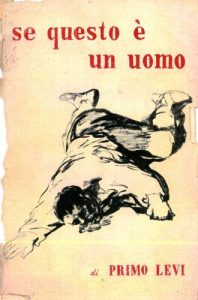
Original cover of Primo Levi’s book in Italian, published in 1947.
Levi was an Italian Jew with a chemistry degree who spent 11 months in Monowitz where he worked as an assistant in IG Farben’s Buna Werke laboratory. Though he had a cushy indoor job, he complained about everything he could think to complain about in his book If this Is a Man (shown right) which he wrote in 1946. A German translation was published in 1961 in which he addressed the German people in a special preface written out of his need to remind them what they had done! (From his book of essays The Drowned and the Saved, Einaudi publishers, 1986, 170 pages)
In If This Is a Man, Levi alludes to “the gas chambers of which all speak” (p.49) but evidently he has neither seen nor met anyone who has seen these things. Then he asks “Is it true what one hears of selections, of gas, of cremation?” and he is answered only with a rumor that persons in the Infirmary who were in decline, who were not going to recover, would be sent to the ‘gas chamber.’ (p.46) That is the extent of Primo Levi’s knowledge of ‘gas chambers’ after one year at Monowitz.
Shortly before the Soviets arrived, Levi came down with scarlet fever and was hospitalized. Not being recovered enough to go on the march to the West, he was still there in the hospital attended by a Jewish doctor when the Soviets “liberated” the abandoned Auschwitz-Birkenau camp.
To be continued in Part 2
6 Comments
Category Featured | Tags: Tags: Andrew Reid, Auschwitz tattoos, Auschwitz-Birkenau, gas chambers, Holocaust fraud, Monowitz, Primo Levi,
Social Networks: Facebook, Twitter, Google Bookmarks, del.icio.us, StumbleUpon, Digg, Reddit, Posterous.
Sunday, June 12th, 2016
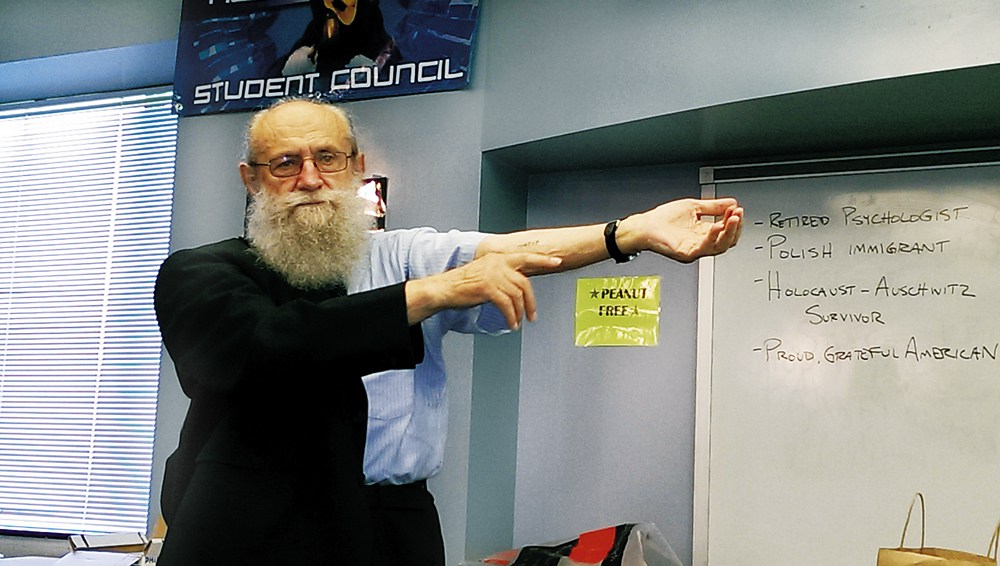
Joseph Hirt points to a number that he had tattooed on his own arm while pretending to be a holocaust survivor at one of the many classrooms in which he has spoken. Hirt was never incarcerated in a concentration camp.
BY CAROLYN YEAGER
Andrew Reid, the New York public school history teacher who says he “believes in truth” has posted his own account of his very thorough investigation into the tales of holocaust survlievor Joseph Hirt on Scribd. online and it is a bombshell. Reid has done in this instance what the media and the schools continually fail to do before they publish a story or allow someone to speak to their students – scrutinize and vet the extravagant claims of holocaust survivors. Of course, the media doesn’t do that because they know the claims won’t hold up; thus one can only conclude the media is helping to defraud the public on the subject of Holocaust. The schools are doing the same out of laziness and mental incompetence.
On pages 27-29 of his document, Reid lays out his idea that Mr. Hirt should have an opportunity to publicly retract his claims and admit his fraud, ask for forgiveness and cease his involvement in any further public presentations. If Hirt refuses to publicly recant, Reid recommends that law enforcement in both Lancaster County, PA and Lewis County, NY should pursue a criminal investigation. Right on, Mr. Reid! It has been the case ever since 1945 that only one side was punished; it’s about time these surlievors are held to legal account too. If they were, there would be a lot fewer of them.
Also at Scribd. Mr. Reid posted a letter he wrote to Joseph Hirt informing him of the above expectations. In it, he said,:
“If I do not see evidence of such a public repentant response in the near future, I will petition the District Attorneys in Lewis and Lancaster Counties to proceed with a criminal investigation, as much of your activity fits the legal definitions (in both the states of New York and Pennsylvania) of felonies and misdemeanors such as fraud, identity theft, and forgery.”
Well, I think Hirt should be prosecuted whether he recants or not. A crime is a crime, and saying you’re sorry doesn’t get a criminal off the hook in any other field. Why should Holocaust hoaxers get special treatment – or continue to, I should say. I also think his family members should be cited for aiding and abetting his fraud by not speaking up. They’ve known for fifteen years that he was lying in schools and public forums, but said nothing until they were asked by Reid.
Interestingly, Reid wrote at Scribd. that “I am not a Holocaust denier – I believe in truth, and if someone is not telling the truth, I wonder what the lie is covering (the”real” truth.)” We have a lot in common! I believe in truth too, and this site Elie Wiesel Cons The World is “A blog dedicated to finding out the truth about Elie Wiesel’s tattoo,” and other aspects of Wiesel’s testimony. Truth is what we’re after. So I am hopeful Mr. Andrew Reid will continue along this path of investigating holocaust survivors. If he does, he might be in for some unpleasant surprises.
We must get as many people as possible to read the several items that he has posted at Scribd. His main report contains photographs and background material that is not included in the regular news reports which, however, are very scanty – in fact, I do not see any major media outlets reporting on it yet. That says a lot, doesn’t it. It looks like we’ll have to push it into the news.
According to an early local news story, Joseph Hirt has been an active holocaust surliever since at least 2001 when he conducted a 10-week adult night school class about his experiences during the “holocaust.” That led to other speaking engagements and “paved the way for a more intense catharsis: putting pen to paper.” This is a reference to a memoir that he has said he was writing, but obviously with no intention of ever finishing or publishing it. He is smart enough to know it would give him away.
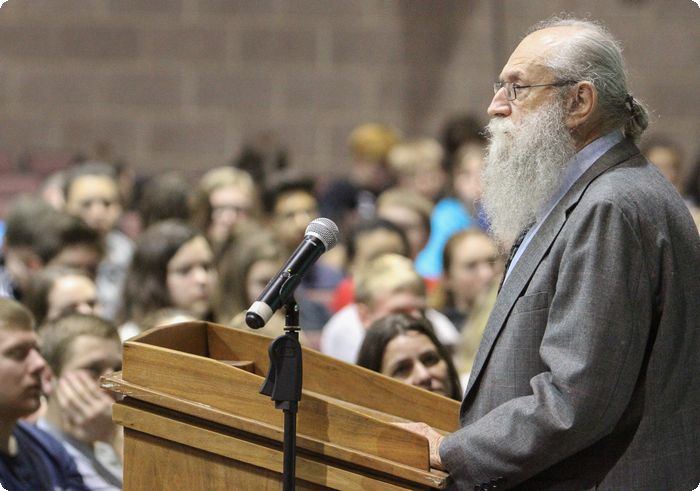
Joseph Hirt speaking to Boyertown High School students in April, 2016. On June 8th, Andrew Reid published the results of his investigation, proving Hirt to be a fraud. No more school talks for him.
He gave as a flimsy reason for remaining silent so long (until 2001) that no one would or could comprehend the horror he had to tell.
“Even today . . . the mere mention of Auschwitz – the name, the word, conjures up images of whippings, of beating, of hunger, of cruelty, of horrible odors and smells, of burnings, of hanging and shootings, of death and destruction,” Hirt writes (in 2006).
Even a friend who became a county court judge continued to believe him. Hirt said that his family is what inspired him to finally speak out. “With two daughters, a son, and six grandchildren, Hirt realized that future generations needed to hear his story.” It’s a fitting irony that today Joseph Hirt has been ostracized by his immediate family and none of his three children will have anything to do with him, according to his nephew. His brother, a retired clinical Psychologist, thinks that Joseph may be delusional and that he actually believes his own stories now.
But no … because his nephew Michael says: “When I confronted him (a couple years ago) he basically claimed that the stories were taken out of context, or that the authors fabricated the stories,” which Michael didn’t believe. However very recently, when reached by phone and asked about Reid’s accusations, Hirt, who lives in the Adamstown area now, stood by his story.
“There’s nothing to defend. I was there and I don’t need to defend it. This is like being forced to defend being raped.”
Hirt has also said he is not Jewish, but is a Polish Christian. However, it is known that he was born to a Jewish family in Poland in 1930, making him 86 years old today, not 90 as he claims. (Another one who can’t tell the truth about his age.)
When it comes to the number Hirt had tattooed on his own arm, 194517, he not only put it in the wrong location on his arm but Reid discovered from Auschwitz-Birkenau records that this number belonged to a man named Kazimierz Sikorski, and it was not assigned until 1944, long after Hirt had “escaped.”
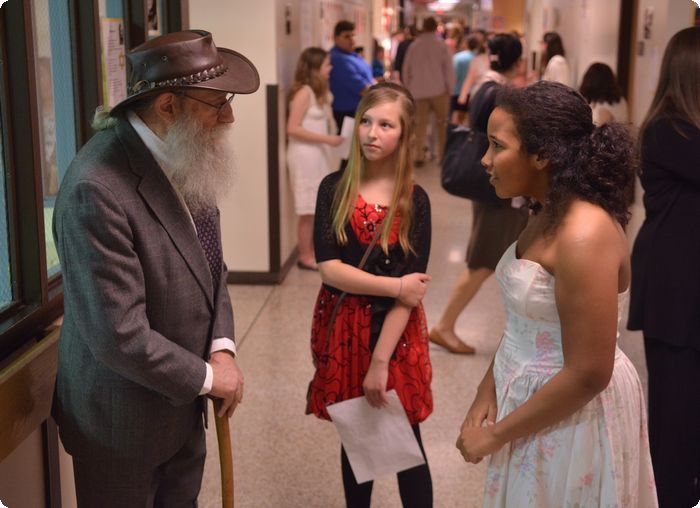
On April 10, 2014, more than 200 students participated in Wilson Southern Middle School’s third annual “Holocaust Hall of Memories.” Joseph Hirt was there, pictured here poisoning the minds of 6th grade girls Samantha Godal, 11, and Jaylinn Maurer, 12. The students do research on a holocaust victim (I guess it was him) and read the story of the victim to family and members of the community. It’s pretty disgusting to see this sick old liar hanging out with tender young girls, filling their minds with horrible stories that have nothing at all to do with their lives. Yuk. The schools are responsible for pushing this unhealthy agenda.
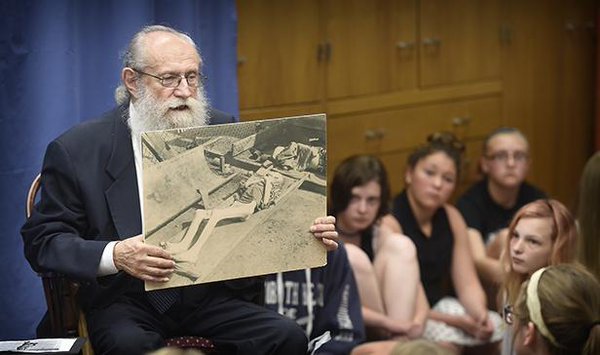
On Tuesday, April 20, 2016, Joseph Hirt, who claims to be 90 though he’s only 86, now a resident of Lancaster County, told his emotional story of surviving the Holocaust to students at the Boyertown High School. He holds a photo that he claims is himself as a teenager, weighing only 60 pounds, sleeping on a stretcher in the Auschwitz concentration camp. And he tells the students that while in that condition he crawled under a fence, talked a German guard into letting him run away very fast before the guard could shoot him, then traveled to Yugoslavia to find his family. Yikes. Just how stupid are we supposed to be? What does this do to the minds of America’s youth who are told to respect and believe what he says?
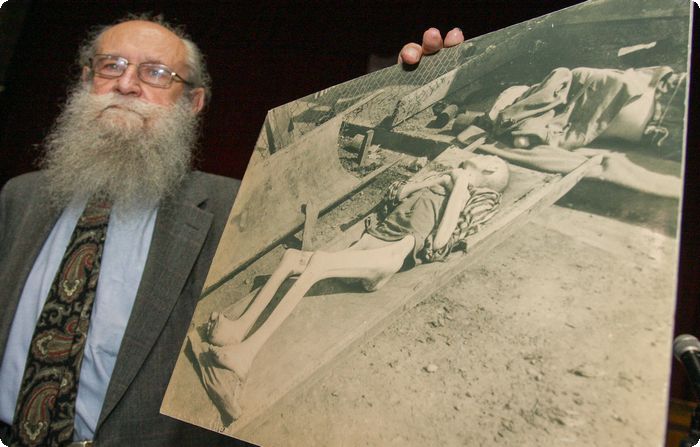
Another picture of Hirt with that photo of a typhus victim at Dachau taken after the liberation, that Hirt tells his young audience is himself in Auschwitz in 1942, a victim of starvation! Why should young people be subjected to such gruesome images that will give them nightmares.
Holocaust “experts” like Deborah Lipstatdt, who took over from Ken Waltzer as the go-to person when frauds pop up (as I wrote about here), are only concerned about how it affects their precious and increasingly fragile Jewish myth. To them it’s sad only because it gives food for argument to “deniers.” They don’t care that schoolchildren are being lied to in their classrooms by speakers they’re told to view with reverence and awe. No, it’s not looked at that way. They believe that everything Hirt says did happen … just not to him. And this is what Hirt believes too, and how he justifies his lies. But I say it did not happen at all since most every surlievor is testifying to things that s/he may have heard about, but did not ever personally experience.
What does Deborah Lipstadt have to say about the outing of Joseph Hirt as a liar?
“The saddest thing is that it causes doubt about other survivors’ stories, which we know are true. The guy is a fake, is a fraud. Had people stopped to check the historical references he made it would have been clear that he was making it all up.”
Why then was it never clear to Lipstadt? As a “holocaust historian,” she has never questioned a single surliever story. Not a single one! She is only concerned with holocaust deniers.
Neither did Aaron Breitbart, a senior researcher at the Simon Wiesenthal Center in Los Angeles, ever look into Hirt’s story that he’s been telling for 15 years. Breitbart said:
“…you’re always going to find someone out there that makes up a story or embellishes a story.”
So what, huh? He added:
“Holocaust deniers, when they find a story that proves not to be true, they use it to deny the entire Holocaust,” he said. “Because you find one thing wrong, everything else is wrong, too.”
But wait. In Hirt’s story, a few things were discovered to be wrong, and it is agreed by all concerned that those crucial errors discredit his entire story. Why then does Aaron Breitbart say it doesn’t work the same with the official Holocaust narrative? Certain crucial errors should bring about the questioning of the entire narrative. The narrative has to withstand scrutiny in every part if it deserves to be believed. And it is the responsibility of those who claim themselves experts, like the Wiesenthal Center, Aaron Breitbart and Deborah Lipstadt, to police their own “industry,” yet they are absolute failures in this regard. The reason why is clear — they know the whole she-bang is a fraud that it is their job to keep propping up. They approve of people like Joseph Hirt and never question them unless they are forced to.
So kudos to Mr. Andrew Reid, a man who cares about the truth. I really hope that, along with following up on Hirt, Reid gets interested in some other surlievors and continues bringing the true facts to light. Be sure to read his report here.
9 Comments
Category Featured | Tags: Tags: Andrew Reid, Auschwitz Tattoo, Deborah Lipstadt, Holocaust fraud, holocaust survivor, Joseph Hirt,
Social Networks: Facebook, Twitter, Google Bookmarks, del.icio.us, StumbleUpon, Digg, Reddit, Posterous.
Wednesday, June 8th, 2016
 BY CAROLYN YEAGER
BY CAROLYN YEAGER
Why is it that no one can mount a sustained argument against the contents of this website? Or even a single good argument. There have been a few who thought they had done so, but after my reply, they disappeared. All I get nowadays are really pathetic, 6th grade-level comments (I wish they really were in the 6th grade; then I might get somewhere with them) like this one from “Leelee” that came a couple of days ago. Rather than post it as a comment (to an article from 2011!), I decided to make an article out of it, as I did with Tiffany Yep. Now Tiffany is a genius compared to Leelee, as you will see. But I’m going to respond to what Leelee says anyway because it’s so typical of the kind of complaints that are sent to this site.
Leelee wrote:
You know what is even more disgusting? That you people think he is a fraud because he won’t show you his numbers. This guy went through something horrific and you won’t give him respect because he won’t show you something that dehumanizes him. Have you actually thought about the truths out weighing the lies? Instead you manipulate people with your little side comments that don’t even give Elie’s true thoughts. If you were only called by numbers and not your God given name (for lets say two years?), would you feel proud of showing people something that made you feel below human, like an animal essentially? Then add starvation,abuse,illness,and disgusting living conditions to that equation. Just use empathy before you accuse somebody, and keep you little side comments to yourself, because it’s not worth dehumanizing someone (again) because you don’t believe that his answers are everything you want to hear or because he won’t show you numbers etched into his skin that he had to hide behind for so long. The human mind is only capable of so much, and Elie is so brave for even telling his story. Please reconsider what you are doing, and base your accusations on a little more proof.
She says Elie’s tattoo “dehumanizes him” and that’s why he won’t show it. Nonsense! He has never said that. If that were his reason he would say so. In fact, he has talked about his tattoo a lot, and used it in his writing and speeches, so if he can talk about it he can show it.
If you were only called by numbers and not your God given name (for lets say two years?), would you feel proud of showing people something that made you feel below human, like an animal essentially?
I never thought that God gave me my name; my mother always said she did. Did God give you the name of Leelee? He wouldn’t be so cruel. It was not two years – you were right to question that – but just under one year. Nor does having a small number tattooed on your arm make you feel like an animal. If you got a number tattooed on your arm, would you feel like an animal? All prison systems give everyone a number and that number is attached to their name because people can have very similar, even identical names — same as in Auschwitz. Why don’t you start a campaign against that practice in today’s prisons? See how far you get.
You are trying to make your thoughts Elie Wiesel’s thoughts but you have no idea what his thoughts are. Nor do I, so I go by his words, not by some imaginary ideas I dream up. You may even be the same person who has written many comments here, saying basically the same thing, using different names. None of these comments have a sincere feeling about them – mainly because they’re so darn silly.
All the suffering you want us to believe Wiesel endured comes out of the fictional book Night. There is no objective proof that he was starved, abused or even ill. There are no witnesses to any of it – it all comes from Elie Wiesel himself. If you think that famous Buchenwald liberation photo shows an image of poor, suffering Elie, you are wrong. I can prove he’s lying about it, anyone can prove it. There is not a single image in existence of him at either Buchenwald or Auschwitz, or in a ghetto.
… because it’s not worth dehumanizing someone (again) because you don’t believe that his answers are everything you want to hear or because he won’t show you numbers etched into his skin that he had to hide behind for so long.
He hid behind the number on his skin? How does that work? You’ve gotten carried away with your own dramatic language. Why not show the number? The only possible reason is because he doesn’t have one. You go on and on about his feeling dehumanized and mentally fragile, when in fact there is no evidence of that. He feels just fine about the power he and his fellow Jews have by using the weapon of the “Holocaust.” He’s very happy about that, and life has been great for him. You are painting a picture of someone who doesn’t exist. Perhaps because you’ve been assigned to this website and you can’t refute what is here so you rely on this kind of righteous indignation.
Please reconsider what you are doing, and base your accusations on a little more proof.
A little more proof? Unreal! I’ve got tons of proof here and you don’t challenge any of it. Instead, you’ve got righteous indignation and you turn things around: accuse your opponent of what are really your failings and vices. You have no proof for the “poor suffering young Elie” myth. If anyone sincerely looks into it, they won’t find real evidence of it; therefore to distract from that lack of evidence you’re taught to resort to emotional charges. What makes me suspect you’re not a girl named Leelee? Because I’ve received so many comments just like yours with girls names attached. Well, it’s possible a lot of high school girls reading Night search Wiesel’s name on the Internet and end up here. It’s possible they get upset about it and send off a comment. But, except for Tiffany’s, they’re all so much the same.
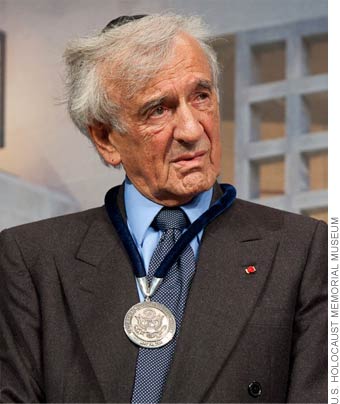
Saint Elie will be canonized in the Catholic Church — expect it! And the Media and public will eat it up.
This brings me back to my original thesis that no one can defend Elie Wiesel’s story with solid evidence. No one ever has. Try to give me an example where you think that has been done. We’re always confronted with sentimentalism and emotional manipulation to cover than lack, which has gotten pretty tired by now. The Elie Wiesel drama is a story, a fiction, make-believe from start to finish. Wiesel only allows himself to be interviewed by friendly Jews, but even at that, he says a lot of things that give him away. He always tells his story just a little differently. But one has to want to see reality in order to notice it. Elie Wiesel’s fans don’t want to notice it. And the mainstream media doesn’t either. When he dies, will we see his life story presented in a major Hollywood movie? You can bet on it … or gag on it. He may have already made known his preference for who should play him.
7 Comments
Category Featured | Tags: Tags: Elie's tattoo, Holocaust fraud, Night,
Social Networks: Facebook, Twitter, Google Bookmarks, del.icio.us, StumbleUpon, Digg, Reddit, Posterous.
Sunday, May 22nd, 2016
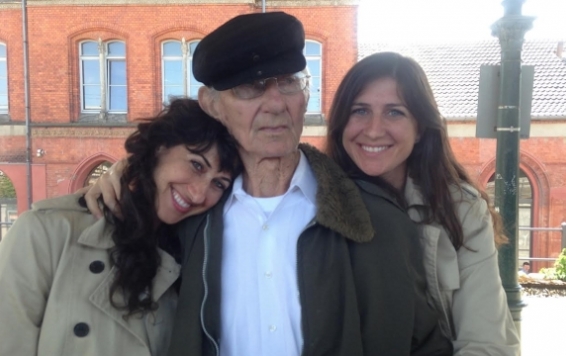
Joshua Kaufman poses with his daughters Alexandra (left) and Rachel in front of the Chabad building in Berlin, after leaving the show-trial in Detmold. (photo from Jewish Journal)
By Carolyn Yeager
That’s not asking too much. He burst on the scene (with the help of Bild news organization) of what is already a show-trial in Detmold, Germany and made it even showier. He sought attention for himself.
He is quoted by NBC News as proclaiming in the courtroom, referring to Auschwitz
“Can you imagine working in a crematorium, when you are only 15 years old? I had to break the bones of the dead to get them untangled … I am not Joshua Kaufman, I am number 109023.”
[Note: It has been discovered, on 7-5-16, that the number Kaufman gave to NBC when speaking about Auschwitz was his Dachau prisoner number. Keep that in mind as you read this article.]
I think, under the circumstances, this statement requires him to tell us if he has this number tattooed on his arm. He sought publicity for his story of being a victim of Auschwitz – no one dragged him into that courtroom as they dragged Reinhold Hanning, the defendant. He can’t selectively say what he wants and hold back what he doesn’t want to say. Plus most of his fellow Auschwitz deportees willingly show their tattoo – those that have one, that is.
I have explained elsewhere that according to the bits and pieces Joshua Kaufman has thrown out there (not in any chronological order, by the way), he cannot have had the Auschwitz number 109023. According to the Auschwitz-Birkenau Museum web site, as a Hungarian Jew arriving at Birkenau in 1944, his number would have been preceded by an ‘A’ followed by a number no higher than 20,000. The number he gives is over 100,000. Because of this discrepancy, which he himself originated, he is responsible for answering how he came up with this number.
A second problem with this statement is that it can be shown he was 16 years old when he would have been in Auschwitz in 1944. Yet he even says he was 15 at Dachau, in 1945. It appears he has chosen the age of 15 for his victim story because it has a better ring to it than does sixteen.
A Media Creation
The media won’t ask such a question or bring up any discrepancies. The Joshua Kaufman story is a media creation. Beginning with the Daily Mail UK‘s trumped-up January 2015 story about a reunion with his American “liberator,” then moving on to Germany’s Bild and it’s before-and-after arrival video, plus the US’s NBC News coverage in the courtroom with Kaufman, it is media creating the news. Yet with these three major news outlets covering the man’s story, we still know practically nothing of substance about Kaufman. All they give us are a few outrageous lies (like the one quoted above), and ‘human interest’ profiles.

A Bild photographer took this picture of Kaufman’s home and work van when a team visited him in California before he even left for Germany to crash the show-trial of Reinhold Hanning. Note Kaufman walking toward his front door.
Here are some things I’ve learned about him from carefully scanning the news articles:
1. He comes from Hungary, born in 1928.
2. He was a “survivor” of the Debrecen ghetto.
3. He was deported to Auschwitz (probably in 1944), then worked in 3 smaller camps, ending the war in Dachau where he was liberated on April 30, 1945.
4. He moved to Israel at an unknown date after the war, stayed there for 25 years (some sources say 30 years) and served in the IDF during two wars in 1967 and 1973, then moved to the United States before 1975.
5. He married at age 47, which would have been in 1975, and had a family of four daughters.
6. He worked as an independent plumber in California.
7. He never talked about his holocaust experience until recently because [he said] he felt guilty about throwing fellow Jews into cement mixers. He’s talking about it now because he says, “In ten years’ time, there will probably be no one left who survived it.”
So let’s start with number one and two:
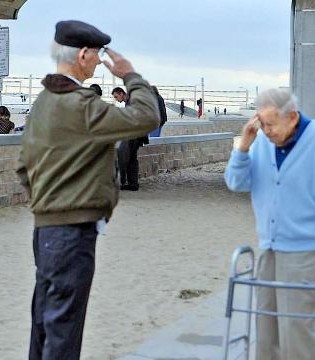
In this cropped photo from the Daily Mail picture layout in January 2015, we can see Kaufman is wearing the exact same clothes he wore in May 2016 at the trial in Detmold, and in Berlin, above.
Kaufman says he is 88 years old in May 2016 which gives him a birth date of 1928. It was his “liberator” Daniel Gillespie (in photo at left) who identified Kaufman to the Daily Mail as a Hungarian Jew. Bild reinforces that by writing that he was a survivor of the Debrecen ghetto:
Kaufman survived the Debrecen ghetto (Hungary). He also survived the Auschwitz and Dachau concentration camps. In Dachau, he was freed on 30 April 1945. Following his liberation, he lived in Israel for 25 years. Kaufman: “In the concentration camp, I was no longer a human being, but an animal. Aged 15, I had to carry 50-kilo bags of cement for more than 12 hours a day. Everyone who could not manage that was thrown into the cement mixer.
Does anyone at Bild really think that exhausted workers were thrown into the cement mixer? I doubt it, but not a questioning word is heard. Checking out the Debrecen ghetto, I found this on Wikipedia:
The order to erect a ghetto there was issued on April 28, 1944. They finished building the ghetto walls on May 15. On June 14 all Debrecen Jews were deported to the nearby Serly brickyards. Most of the Debrecen Jews were deported to Auschwitz, arriving there on July 3, 1944.
The Debrecen ghetto was only used for one month before they were deported to Auschwitz. Kaufman, being among them, wouldn’t have arrived until July 3, 1944, and spent only 10 months at various camps. Or, he never left Hungary at all.
Debrecen was liberated by the Soviet Army on 20 October 1944. Some 4,000 Jews of Debrecen and its surroundings survived the war, creating a community of 4,640 in 1946 – the largest in the region. About 400 of those moved to Israel, and many others moved to the west by 1970.
Considering he doesn’t say when he was arrested, or what he did immediately after liberation from Dachau, he could very well be one of the 400 who moved to Israel from Debrecen and then to the United States in the 1970’s. But, in any case, his alleged Auschwitz number doesn’t fit his history, as far as we can know it. More on that in a moment. First I want to include some history of Debrecen, Hungary’s second largest city, from Wikipedia:
Jews were first allowed to settle in Debrecen in 1814, with an initial population count of 118 men within 4 years. Twenty years later, they were allowed to purchase land and homes. By 1919, they consisted 10% of the population (with over 10,000 community members listed) and owned almost half of the large properties in and around the town
In 100 years they went from 0 to 10% of the population, from 118 to 10,000, and owned 50% of the large properties. This is why they were and are resented. The mistake came when they were given the same rights as Hungarians by being allowed to purchase land and homes anywhere. If individual Jews are not wealthy themselves, they get money from Jews who are wealthy, even abroad, and buy up everything they can as their agent. So the Hungarians were glad to get rid of these Jews when they were deported — not to a death camp but to a labor or detention camp.
At that time, in 1944, Kaufman was 16 years old. He has shown pictures of himself in the Bild video in which he appears to be a well-to-do Jew, both before and after his “ordeal.”
More on Kaufman’s history
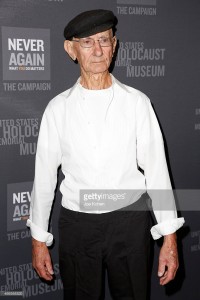
Lookee here. Now-”famous-holocaust-survivor” Joshua Kaufman attends the United States Holocaust Memorial Museum 2015 Los Angeles Dinner at The Beverly Hilton Hotel on March 16, 2015 in Beverly Hills, California. The big layout in the Daily Mail appeared only two months earlier in January 2015. He became a star.
Of numbers 3 through 6, I have no further information than what is stated.
Number 7 tells us that Kaufman’s objective is to help the Jewish case for “The Holocaust,” just like Martin Gray, Elie Wiesel and Paul Argiewicz, and hundreds of others. It’s not about reality but about what’s good for the Jews. Kaufman jumps right into it.
“I lost 100 members of my family, At age 15, I was working in a gas chamber in Auschwitz, dragging out bodies.”
If he became a “sondercommando” working in a gas chamber, he would certainly have been tattooed. Bild newspaper was even told that he had to transport the dead bodies out of the gas chamber with a wheelbarrow. “In Auschwitz, Kaufman had to transport the dead bodies out of the gas chamber with a wheelbarrow. He will talk about this during the trial,” they wrote. A wheelbarrow!? Excuse me, but I have to laugh at that. With 20,000 allegedly gassed per day at that time, you would need a hundred people like him, all bumping into each other with their wheelbarrows!
Then this man Kaufman, who does not answer questions himself, has the gall to make demands on defendant Hanning:
“I would like to hear answers from him. How can you act this inhumanely? How can you live with it? How was he able to happily go home to his family in the evenings? I want him to beg for forgiveness.”
Who is this guy lecturing Germans – showing up at an on-going trial, whether it be right or wrong (it’s wrong, but he’s not trying to right it), with his highly questionable story? What a completely arrogant human being. He goes on:
“They should know what happened to us. In ten years’ time, there will probably be no one left who survived it. That’s why I am talking about it now. For a long time, I did not [talk about it] because I did not feel like a hero. I felt guilty. After all, I had to throw people into the cement mixer, too. Not a single minute passes without my having to think of Auschwitz. I will speak for everyone who did not survive.” (Except it was at Dachau where he says he threw people into the cement mixer.)
He was not a hero! He now thinks people see him that way, after all the movies and books and endless newspaper stories he’s seen over the past 50 years. In the Bild video, he gives himself away by anticipating disbelief in advance, saying: “Everything I did – and nothing is copied from a book and nothing from a movie – everything myself experienced.” That means it’s just the opposite. It was all copied because he only mentions extreme things that never took place in reality. His goal is to exemplify the “Nazis” as evil personified and himself as an innocent survivor of that evil, but what he chooses to say portrays him as just the opposite. As a villain. He “broke the bones” of dead Jews and threw others in a cement mixer!
He volunteered for the ‘gas chamber’ work at Auschwitz
Orit Arfa, a friend of Kaufman’s daughters, wrote a story published in the Jewish Journal of her meeting with the three of them after they left Detmold and came to Berlin. The occasion was a Shabbat (Friday night) dinner at an Orthodox Chabad meeting place. Orit called Joshua “Yehoshua” and said “he had hurt his knee a few weeks earlier but decided he must travel to Germany to seek justice.”
Justice?! For whom? More justice for Jews is all he can mean. She wrote:
He had prepared his words, how he had lugged dead bodies out of Auschwitz gas chambers, pulling them apart as they stuck together during their murder. He was 15 at the time, and volunteering for such gruesome work helped keep him alive.
I get the feeling she read this in the news accounts of the trial, don’t you? Maybe she then asked him about it because she quoted Kaufman as saying:
“It was a way for me to stay alive and to see what was going on around the camp,” Yehoshua related at the Chabad table.
How casually stated! He volunteered to assist in the gassing and cremating of fellow Hungarian Jews in order to stay alive himself! Since he has also said he was sent out to work from Auschwitz, that is not what kept him alive. Big Lie. Another reason was to see what was going on around the camp? Like a tourist? Or a detective? How superficial and unfeeling is this statement. Note he doesn’t say which gas chamber or crematorium he worked in, as if there were only one. Funny no one asked him. But then Orit tells us:
But he seemed more interested in discussing other subjects, like why I wasn’t married. […] He enthused how pleased he was to see me, and how glad they decided to go to Chabad in the end, despite physical and emotional exhaustion from long train rides and legal roller coasters. He looked proudly around the room of Jews singing Shabbat hymns.
So he wants to change the subject, does he? He’s not interested in going into any detail about his stories. This, I think, is the most important sentence I’ve come across, that he didn’t want to discuss it further. He had his “prepared words” and that’s all he had.
After berating Reinhold Hanning for not confessing to what he did not do and did not know, but remaining silent, Joshua Kaufman reveals himself as the most silent of all when it comes to what he doesn’t know and did not do. The Media also remains silent in the face of obvious and important contradictions and impossible claims. Both Kaufman and the Media are engaging in a hypocrisy so entrenched the public barely notices it. But I notice it and I want to know:
How does Kaufman explain his number 109023? Where is his tattoo? I am demanding answers from him. Why don’t you join me.
8 Comments
Category Featured | Tags: Tags: Auschwitz-Birkenau, Bild, Dachau, Daily Mail, Holocaust fraud, Joshua Kaufman, NBC News, Reinhold Hanning,
Social Networks: Facebook, Twitter, Google Bookmarks, del.icio.us, StumbleUpon, Digg, Reddit, Posterous.
Sunday, April 24th, 2016
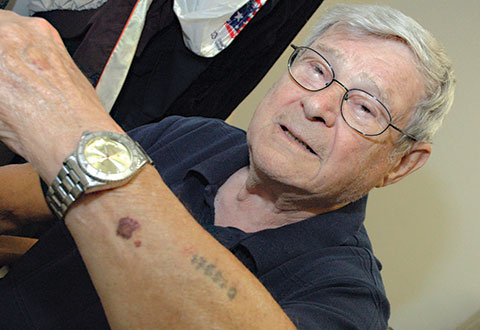
Paul Argiewicz proudly shows off his Auschwitz tattoo which is his best proof he is a holocaust survivor. But it’s the details of his story that are suspect, as is true of all ‘surlievor’ stories.
By Carolyn Yeager
THERE HAS NEVER BEEN a survivor story that passes the test of truth and accuracy – not one! Isn’t that amazing? They are all filled with exaggerations and downright lies. And that really tells us something, because “the Holocaust” is in actuality nothing more than a collection of survivor stories. I am not an expert in revisionist historiography, but I think I can say with confidence that no scientific/forensic evidentiary support for a “Holocaust” exists. Documentary support is both sparse and dependent on questionable or uncertain interpretations. That leaves us with witness accounts from those who were in the concentration and work camps to tell us what “the Holocaust” was.
It’s been known for a long time that eye-witnesses are the least reliable evidence for what really happened in any given situation. Forensic evidence is the best, and even circumstantial evidence is superior to eye-witnesses. The stories that were told by false eye-witnesses in 1945-46 were outlandish compared to what we believe today. Far-fetched and grotesque accusations of sadistic methods of killing were made against camp authorities and guards and then soberly reported in the world’s news outlets. The remaining leaders of National-Socialist Germany were executed by hanging after being found guilty by an unlawful tribunal of war victors without so much as a peep heard against it in the mainstream media of the time. With the help of the Internet and revisionist historians, we have come a long way since then in using our critical judgment when it comes to blatant atrocity propaganda. Now I think it’s time to encourage even more and tougher critical thinking about the stories survivors have told and are still telling.
There are certain elements all the stories have – that’s why they’re a genre. They’re almost all written by Jews. They describe awful conditions in the camps with more generalization than specifics, ie. barracks, food, work, supervision, guards and, of course, Dr. Mengele if they were at Auschwitz-Birkenau. One common observation made by those who arrived by train at Birkenau is that they saw in the distance smoke and flames coming out of the crematorium chimney. Sometimes there was a bad odor. It is known by people educated in these matters that cremation does not create smoke or odor, and that flames cannot leap out of a chimney unless it is dangerously malfunctioning. But enjoinders to stop contradicting the laws of nature and science make no impression on these story-tellers. They are following a higher law of “Never Again,” which makes lying permissible and the impossible possible. I’ve come up with the word ‘surlievor’ for them, which I’ll use from here on.
With this introduction in mind, let’s look at Paul Argiewicz’ story again. I wrote about this man last week and tried to stress two major points: his lies about his birth date and about being in the Famous Buchenwald Lieberation Photo. But when I read fully through the Oral History he did with the Wisconsin Veteran’s History Museum, I discovered a few more major problems in his story. Using the critical method on Paul’s Story will show us why all surlievor stories are just that — stories so fictionalized that they are totally unreliable as history. They are meant to propagandize, and they do, but for most who read them, they also serve as entertainment in the widest sense.
The real Paul Argiewicz
If you read the above-mentioned oral history interview and then read Paul’s obituary placed in his hometown newspaper you find some very different facts in the places where it counts most. For more than a decade before his death at age 88, Argiewicz was known as a regular out-patient at the veterans hospital near where he lived. The personnel there, along with the U.S. Social Security Agency, the Veteran’s Administration, and other agencies he dealt with, had his correct date of birth. That’s why his obituary gives it correctly as 1925. Then there’s a newspaper report (also here) of a 2010 presentation he made to a high school group that is different still. I have not read the biography written by Deanne Joseph, but I know that she fictionalizes his story too. I’m sure the “Oral History” from the year 2000 is more revealing than the story written by a professional writer hoping for a best-seller – or at least a good seller able to fulfill the curriculum needs at thousands of middle schools. In this interview at least, the real Paul Argiewicz does come through.
Some trivia: Even though the interview took place in 2000, it was not transcribed until 2008-09. The book by Deanne Joseph also came out in 2008. Katy Marty transcribed the interview; it was corrected by Channing Welch, after which the corrected copy was typed by Katy Marty. Since the interviewer James (Jim) McIntosh and Argiewicz talked over each other fairly often, it’s evident these ladies did a commendable job.
Sheryl Erdman Argiewicz, Paul’s wife, is present and says something from time to time. Right in the beginning Paul says, “Why don’t I have my wife with me?” and Mrs. A, who is apparently not seated just right next to him, says, “No just do it on your own honey.” Then she added, “I’ll just prompt you when you forget, alright?” And several times she answers questions for him.
At the time of the recording, they have been married four years. Paul is 75 years old. This is important because, from what he says later in the interview, he didn’t began to speak about being a holocaust surlievor until after they married in July 1996 when he was age 71. His first wife had died and he began looking for another. He said of Sheryl, “She was available,” but not in a derogatory way. He was clearly very dependent on her.
The revelation that, like so many others, he didn’t talk about the holocaust until after Schindler’s List became a big hit in 1993 and Hollywood made being a surlievor fashionable, puts the biggest question mark around Argiewicz, to my mind. Surlievor “meet groups” cropped up at that time wherever there were a lot of retired Jews. They got together and told their stories to each other, while Stephen Spielberg got the idea to tape record and archive as many surlievor stories as possible – thousands of them! [Thanks to Eric Hunt, we have been able to see a lot of them and can easily recognize the nutty things and enormous lies so many of them tell.] It sure appears it was Paul’s new wife that encouraged him to “go on the speakers circuit” as a holocaust surlievor. In fact, Sheryl’s daughter Cindy is one of the biggest boosters of her father-in-law’s story.
13 Major problems in Paul’s one-on-one interview
1. He didn’t speak publicly about being a holocaust survivor until he was in his 70’s, after remarrying in 1996.
Page 56: MR. A: And we knew each other [his current wife Sheryl]. And she turned a lot in my life, a big change in my life. Literally, I couldn’t talk to you. Like you would ask me today about the interview what you give me. I would never give it to you. I would walk out.
JIM: Too tight?
MR. A: I was so tight I would walk out. I just, I just didn’t work. And this lady here made about face. She opened me and I became –
Unfortunately a major interruption occurs at this point and he doesn’t get back to it. But he’s telling us he never spoke about it and it is Jim who puts the words “too tight” in Paul’s mouth. Jim is very often doing this, or finishing Paul’s sentences, and Paul just accepts the word Jim gives him. Not what should happen in something billed as an Oral History
2. Claims he was born in 1933, when his actual birth date is 1925.
Page 6: MR. A: I was born in Bielsko, Poland.
JIM: Boy, you better spell that one.
Mr. A. B-i-e-l-s-k-o, Poland.
JIM: When?
MR. A: In 1933.
JIM: ’33?
MR. A: Yeah.
This is pretty ridiculous because he makes himself 8 years younger when, according to his own story, he should be 5 years younger. Jim even gave him an opportunity to change it, yet Paul stuck with 1933 and his wife didn’t correct him. In a speech to a Jewish group I just happened to see on Youtube yesterday, he said: ‘In 1939 I was 10 years old,’ making his birth in 1929. So you see how it moves around.
3. Claims he was 10 years old when his family moved to the Sosnowiec ghetto, which would have been in 1943 according to the birth date he gives. And his wife answers for him.
Page 8: MR. A: First I got into ghetto in Sosnowiec.
JIM: Age? Your age?
MRS. A: Ten, when you went in the ghetto.
MR. A: In the ghetto I was ten.
Sheryl apparently didn’t trust him to tell it right, or maybe he paused. But the timing is way off , showing that they don’t seem to get it that his dates are not aligned. Nor do they consider whether one part of his story fits with another part further on. If he was born in 1933, he was 10 in 1943. The Sosnowiec ghetto was liquidated in 1943, with the inhabitants being sent to Auschwitz-Birkenau. The real Paul Argiewicz was 18 years old in 1943!
4. Claims he was only 11 years old when “arrested by the Nazis”. But what year is it? He never tells us the year, only his age.
Page 9: MR. A: Okay, and we were in that ghetto for almost a year.
JIM: Your family?
MR. A: My whole family.
The Sosnowiec ghetto was formed over time, from 1940 to 1943, with transfers of Jews from the surrounding areas. According to the Wikipedia page (which is really useless) it wasn’t “closed off” until March 10, 1943. The real Paul Argiewicz was 11 years old in 1936 – that’s a long way from living in the ghetto. One has to doubt his entire “arrest for stealing bread” story and conclude he was simply deported to Auschwitz with the rest of his family in 1943.
5. Claims he told the SS officer in charge that he was 18 and was believed.
Page 10: MR. A: And a guy behind me kicked me in the shin and said to me in Jewish he said to me, “Say to him that you are 18.” And I was almost, I was just about eleven years old. But I was very husky built and strong. [He was a short person with a baby face. A minor problem here is that Paul says further on that he only learned Jewish in the camps but he understood this guy talking to him in “Jewish”, meaning Yiddish.]
MR. A: I said, “Eighteen.” I became instantly eighteen years of age. [Funny that in 1943 he really was 18 years old!]
JIM: Here, here
MR. A: So from the beginning you had your name and they kept your address, whatever it was. They sent me to a camp, what it was actually an “arbeitslager”, a work camp and we were working on the Autobahn.
So he gave his address, he says. It’s possible he was sent to work on the Autobahn at first, since he was the right age – 18. Strangely, his surviving sister Lucy, around his age, has said nothing one way or the other [maybe she doesn’t want to contradict her brother], although her husband tells of his experiences after the Germans crossed into Poland when he was 13 years old – he was one year younger than Paul, in the same town, and they were friends. Matzner says his family lived in the ghetto until 1942 when all the Jews were sent to Auschwitz. He was young (16 then) and able to work. It would have been the same for Paul’s family. But Paul wants to stand-out from the rest … by being arrested and incarcerated as a child. His sister and her husband just stay quiet about it
Note that in the article Robert Matzner tells of lucking out with a work assignment in a surveyor’s heated office because he could speak German, and being brought sandwiches every day by the secretary. Remember this when we get to the “sandwich” part in Paul’s story.
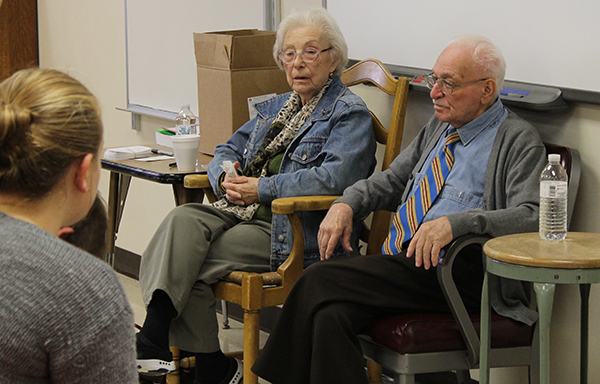
Lucy Argiewicz Matzner and Robert Matzner speaking to 8th graders at Riverview Middle School in Wisconsin about “genocide.” Robert said he spent time in six different camps, all about the same, with little food and 14 hours of hard labor a day. The work days were actually only 8-10 hours and the food was sufficient until the very end. Why do they all have to exaggerate their hardship? They’ve lived a great life ever since.
6. Claims he was multilingual from the start, spoke perfect German
Page 10: MR. A: …where I come from– It’s on the eastern part, southeastern part of Poland. […] So it was very close to Germany, and close to Czechoslovakia. That’s why I was born with three languages. I speak fluently German, Czech, and I speak Polish.
MRS. A: English, of course.
MR. A: And Jewish I didn’t spoke until I got in concentration camp.
This is only a problem in his story in that it would have helped him get along with the Germans running the camp. He says he worked as an electrician, but just bluffed his way through. Not possible to bluff electrical work! But being multilingual enabled him to collaborate with the authorities and get cushy positions where his languages – especially German – were useful. So I’m questioning his suffering. He’s torn between representing himself as a starving laborer and bragging about how important he was. Everything he says about work is sketchy and disjointed; he avoids talking about it because he doesn’t want to be seen as a rat. That may be one reason he came up with the 11-year-old child story.
I’ll add that what he calls perfect German could not have been perfect (but passable) considering how terrible his English is.
7. Claims in the camps they were fed only 1 kilo (2.2 lbs) of rye bread made with sawdust or other filler daily along with potato/vegetable “peelings” made into a watery soup. In addition, he said a bowl of ‘watery’ oatmeal was given at noon to those who worked.
Page 17-18: JIM: Tell me about feeding you. How about eating.
MR. A: The food that we used to get about in the evening you used to get I would say kilo bread, rye bread, about a portion like this. It was filled full with filler. It was not flour. It was — Sawdust. — to fill it up. It was very low in calories, and practically nothing in protein, but one thing the Germans didn’t know about. That they were feeding us. They were feeding us with peelings, dried up peelings. And this (unintelligible), that was very high in protein, very high in vitamins. This, they had this – this they thought that the —
JIM: Peelings of what? Potatoes?
MR. A: Potatoes,
MRS. A: Carrots, vegetables —
MR. A: Carrots, cabbage, anything would work.
MRS. A: Animal feed –
MR. A: In a soup, cooked in a soup.
JIM: Yeah, that, and bread that was your meal.
MR. A: Very thin. That was main stable.
MRS. A: And oatmeal, watery oatmeal in the morning.
MR. A: The oatmeal we were getting around lunch time. The people what worked only. The people what didn’t work got only one meal a day. They didn’t even get —
JIM: If you worked you got two.
MR. A: Yeah. You got two meals. You got the bonka suppe. The “bonka suppe” that used to be … Was watered down oatmeal just like I would say a little bit thicker then that water.
This doesn’t compute with what the German records show and with what many others say, but it does match what the worst of the surlievors say. Germans were not stupid enough to think starving people can make good workers. Everyone got at least two meals a day; physical laborers got four. They also were allowed to receive food packages from home and from the Red Cross and Jewish agencies. Even though Paul likes to talk about starvation, it was not happening, certainly not to him.
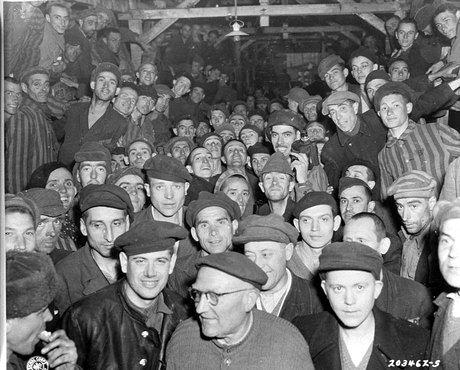
“Starving” Buchenwald prisoners at liberation. They sure look well-fed to me.
8. Couldn’t say how deep the bunk beds were in the barracks, whether 3 or 4 layers. Said he could show a picture from a magazine!
Page 19: JIM: The bunks were how deep or how high?
MR. A: Ah, in some places we used to have three and four —
JIM: Three or four?
MR. A: In Buchenwald I remember, what was it, three or four I think. Was it three there or four layers?
MRS. A: (unintelligible) three.
MR. A: Whatever it was. I have pictures. I bet, in fact I’d like to show you the picture from U.S. News and World Report.
This is a good place to remark that there is not a single picture of our hero in any camp, or anywhere, from this period. We are taking his word that he was there. Like Wiesel, he thought to prove his claim by identifying himself in that “Famous Buchenwald Photo” but it hasn’t worked out. He’s not in it. It’s pretty funny that he can’t say immediately how many layers to the bunks in Buchenwald if he was there, as he says, for 4 months — It’s hilarious that he asks his wife — he thinks she knows more than he does!
9. Claims he worked as an electrician in the camps. How did he become an electrician?
Says he was only a couple of days at Auschwitz (long enough to get a tattoo), then was moved because “I said I could work.” Says “They moved because they needed electricians.” He appears to mean going from Auschwitz to Blechhammer , not from Blechhammer to Buchenwald in Dec. ’44. I wasn’t able to find any information on quarries at Blechhammer, but we know there was a big one at Buchenwald.
Page 20-21: MR. A: The people would work in the steinbruch [stone pit], like in the quarries, or on the railroad they had no communication because they were all in gangs. Like in chain gangs. [not actual chain gangs] But I was working with a civilian as an electrician so I used to go around –
JIM: Outside the camp or inside?
MR. A: Outside the camp and inside the factory. The factory was almost thirty square miles. Blechhammer, ooh, that was one of the biggest AEG farm industry plan.
JIM: You mean continuous building, or did it just multiple buildings?
MR. A: There were hundreds of buildings in all different sections. They were making out of the coal gasoline [End of tape 1, side A ca.30 min] gasoline but the factory was still in process of building it. They were not completed. Then the Americans and the British denied it to be finished, but they already produced gasoline, because this was the most important thing because out of coal you had almost a hundred different products.
MR. A: Because they used to make ah, medicine out of it. They were making oil, gas, — Soap, whatever petroleum by product was producing.
JIM: How did you get there? [meaning into the big factory buildings at Blechhammer]
MR. A: How? Because I used to go with this man. Every day the guy, I used to come to him in his little cubbyhole he had. He had a few electricians with him working. He used to be the foreman and I used to be his go-fer.
JIM: Did you walk to this job? Or –
MR. A: No, the SS men used to bring me over to drop me off and he had to sign every day a paper.
JIM: This is how far away?
MR. A: Oh, I would say maybe a half a mile.
MR. A: Okay. So I came there and he says, “All right.” “What I did was in the morning, used to come I put the water on so coffee and I worked with him, oh, maybe a month. He was very leery of me, very careful with me. After all, I still was a dirty Jew. This was at Buchenwald.
JIM: And he was a Pole. A Pollock?
MR. A: No, I wouldn’t trust him. I was, he was a real German.
He was talking about Blechhammer, then the SAME STORY moves to Buchenwald. It’s totally confusing. He was never an electrician at Blechhammer if he wasn’t one when he got to Buchenwald. Says he was only a ‘helper’, a ‘go-fer’ in Buchenwald, probably because he spoke German and could work for the Germans in charge, or even Czech or Polish skilled workers. But he passes himself off as an electrician and Jim lets him do it.
Another thing that comes through with Paul is that he likes and respects Germans. He obviously had a lot of interaction with them. So he blames all the bad stuff on Nazis and Austrians (says Hitler was an Austrian, not a German!).
10. Also claims he learned electrical work in Buchenwald in January-February 1945 – a wild story.
Continued from above … page 21-23:
MR. A: He was a German and a very kind person. I never realized yet what this man was. So after a month working with him he comes to me says, “Pauliken, stop with your lies. Tell me the truth. You are not an electrician, are you?” And I looked in his eyes, with tears in my eyes, I remember that, and I said, “No.” That saved my life. [Everything saves his life. He’s obviously sensitive to the fact that he survived when so many didn’t, as the story goes. But also, it would not have taken the German foreman an entire month to discover Paul was not an electrician!] And he hesitated for a second and he closed his eyes and he took the pencil like this, he put it down. He closed his eyes, he put his hands like this. When he opened his eyes he says to me “Paul, Pauliken,” he said, “you know –
JIM: Little Paul.
MR. A: “Little Paul,” he said, “I will save you. Whatever I can, I will do but I want you to keep your mouth shut. Whatever people ask you, ‘I don’t know’, – and they won’t ask you for anything.”
MR. A: “You haven’t seen anything.”
MR. A: I don’t know anything, and that’s going to be the best thing. So all of a sudden he opens this little box. He gives me a sandwich. I never had a sandwich like this even when I was a kid.
MR. A: So he gives me a sandwich. I ate the sandwich. He says, “Don’t ever say nothing.” A week later he came to work. Well, he comes every day, but he came with tears and crying and everything. I don’t remember his last name. I said, “Hans, mit zu Ruhe?” And all of the sudden he breaks down. He says, “I lost my mother, I lost my wife, and I lost my children in Dresden in the bombing. He said, “I have nothing. What did that animal do to us.” He didn’t say the word Hitler.
This is Feb. 15, 1945. But he would never have addressed this man by his first name; plus Hans is a common German name to easily come up with. He “doesn’t remember his last name” so that he can’t be tracked in camp records and found not to exist. Most importantly, he’s making out that “good” Germans like Hans hated Hitler. And does the sandwich idea come from his brother-in-law’s story? I suspect so.
JIM: Right.
MR. A: He says Was has das, no, he said “Welche art schweine mach” to us, what kind of swine, what he did to us. And I didn’t say a word to him. He became so close to me.
No German at that time would have blamed Hitler for Dresden. Never. This simply didn’t take place.
JIM: You were a replacement.
MR. A: I was his – and when the SS men came he said, “Oh this kid? He is essential. He is such an important person. He knows everything.” And he by teaching me how to wire things and how to do things, and he says, “Certain things I used to do backwards on purpose so they would have to call you to find if there’s any troubles on the line because you know about it.” And he says, “You’ve got to be so important that they will not kill you.” And when we used to go over there when the angriffe [attack] used to be the luftangriffe [air attack], the bombing used to come, and you could hear the siren. Everybody went for the shelters. They wouldn’t let prisoners from concentration camp people in the shelters but they let me in.
So he taught Paul to “wire things,” and even backwards, in one month? And this was in Feb-March 1945, after Dresden? It’s just not credible.
MR. A: I had the special ribbon on my thing.
JIM: Oh, really?
MR. A: Uh huh, and I had a special instrument to save those instruments for testing. I used to carry them. He [Hans] said, “You grab those and run with them. They gonna have to let you in because these instruments are more important than you.” And that’s how I saved my life. And a lot of guys got killed.
MR. A: And he used to be a foreman. He used to be a very big person at Blechhammer. And he taught me how to wire the turbines. This was got to be a perfect job. You can imagine the turbines were, each turbine was as long as this room here.
“He” can only mean “Hans.” But now “Hans” is at Blechhammer and teaching Paul to wire turbines! If he did this at Blechhammer, he would not say at Buchenwald, “Tell me the truth, you are not an electrician, are you.”
In any case, never would an uneducated teenage Polish hooligan like him be allowed to work on the turbines at Blechhammer. Plus, Paul said he made his living as a steamfitter in the United States, not an electrician.
11. Said the only day off was Sunday and “all you had [was] hazing, hanging, beating.” And sometime when they came back from work they had to watch “four or five people being hanged.”
Page 29: MR. A: Because when I stayed home for some reason on Saturday and Sunday we didn’t work.
MR. A: No, Saturday we worked Sunday the only one day we didn’t work. That’s all you had hazing, hanging, beating. [It was generally the rule at Auschwitz camps to work til noon on Saturday, then have the rest of the day and Sunday off. We know the inmates engaged in recreation. So he was right the first time.]
JIM: Oh really.
MR. A: Hanging, and sometime when we came from work we had to stay in crowd watching four or five people be hanged. Terrorizing people, keep them for no reason. For nothing.
JIM: Just for entertainment?
MR. A: Just for entertainment, yeah. When I used to come in through the doors and I could hear the music playing, they had a four or five guys’ instruments and when I heard the music playing we knew right away there would be hanging. And the worse thing one time happened to me, this I never will forget. I was already about two years in Blechhammer on Yom Kippur Eve. You see he knew about it. How did I know all these things? I worked with this guy, sometime I used to pick up an old paper what be thrown away.
Shades of Elie Wiesel’s Night. I have not seen anything about public hangings at Buchenwald, but the discipline in the camp was totally under the control of the communist inmate organization, who had managed to take it over in 1943, not the SS. I would bet Argiewicz never saw a hanging in his life. He doesn’t describe anything about it – how, who, why, etc.
We don’t learn “what happened to him one time.” He started talking about the Voelkischer Beobachter and Julius Streicher instead, and Jim never brought him back to it.
12. Claims before liberation in Buchenwald, in his barracks they were frying human bodies for food – “Take a knife and cut off the flesh and eat it.”
There is a story of cannibalism at Bergen-Belson; I don’t know how true it is. It comes from a General quoting a medical officer.
“The prison doctors tell me that cannibalism is going on,” the medical officer said. “There was no flesh on the bodies; the liver, kidneys, and heart were knifed out.”
But I don’t find anything at all about Buchenwald. Argiewicz must have copied what he had read about Belsen. He stresses several times how much reading he’s done, that he is self-educated. He talks about the day of liberation on page 35:
MR.A: On one morning I get up, I hear shoot – we were making fire and frying human bodies. Take a knife and cut off the flesh and eat it.
JIM: Where was this?
MR. A: In Buchenwald.
JIM: Who was doing this?
MR. A: We did, the inmates because there was no food.
MR. A: We became a lot of guys became –
JIM: Cannibals.
MR. A: Cannibals. That’s sad. So, one morning I hear shooting and trembling and I look outside and here I see a green tank with white markings, you know, olive green come right through the gate, not through the gate, through the barbed wires. And I see he stopped and I see the turret with the barrel facing one of the towers when all of the sudden a salvo I hear. The whole tower, you know can imagine, what is it? A hundred,what is it? A big barrel – I heard a salvo.
Jim wasn’t interested in finding out whose bodies they were cooking! Were dead bodies just laying about? Paul would like you to think so. Jim doesn’t care about telling lies because he does it too. On page 54:
JIM: You havin’ fun –
MR. A: Give you a lot of baloney. (laughs)
JIM: Oh sure, I like that.
13. Claims he was on a four-week death march from Blechhammer to Buchenwald in November 1944.
Page 38: JIM: Tell me about the death march.
MR. A: When the Germans were caving in, they were losing the war in the east, and the German army already, the Russian army already entered Poland and as they were going towards Germany so they came by Kattowitz, Katowice. This was right on the German border with approximately I would say maybe sixty kilometers, seventy kilometers about 45 miles from our camp. One day they gave each one of ‘em whole loaf of bread and took us on a four week death march. When we left there were about 3,000 prisoners. By the time we got to Buchenwald there were only 800 left, maybe, and whoever couldn’t walk, they came and rolled you over with their foot, you know on your back. They shot you. That was their favorite, right here. So when they shot you they gave you instant, instant death. You didn’t even feel it, you know when you get shot right through, through the back, and that was their favorite.
From Jewish Virtual Library:
On January 21, 1945, 4,000 prisoners, including 150 women, were taken out of the camp and put on a death march lasting 13 days.
Page 39: MR. A: It is sad to say lot of these guys escaped into this country. And a lot of ‘em [speaking of “Nazis.” And what about all the horrible Jews like Paul that escaped into this country?]
JIM: Yeah, that’s another subject now. Let’s not get off into that.
MR. A: I know, but I would like to tell you about it, the subject, how –
JIM: Yeah, I’m perfectly willing to listen to that. It’s just that I don’t want to get off our track here.
MR. A: Off our track, right. But what happened, we got into Buchenwald and the day when we got into Buchenwald, not to Buchenwald, to Blech – to Weimar. So of course the American pilots didn’t see that we were on the bottom. [They were now in a train, which he forgot to mention] And most of the guys what used to be in the open railroad and cars and when the artillery starts shooting I can imagine, you can imagine, the shrapnels were flying all over, and I knew and I could see how the guys were killed in the cars, so I jumped out of the car, railroad car, because the guards ran away. They hid in bunkers. And I jumped underneath the train, the railroad car and I got saved because sometime, you know, the metal pieces, and when I came back I saw half the car was dead. [Did nobody but him have the idea to jump out of the car?]
[…]
MR. A: Because, you see when we left on the march it was in November, November, and then we got into Buchenwald, I think it was in December.
JIM: You were on the road a month?
MR. A: About a month, yea.
All sources I find put the march from Blechhammer to Buchenwald beginning on Jan 21, 1945, lasting 13 days, half the time Paul claims. He says it was November and they arrived at Buchenwald in December 1944. Big discrepancy here. There were not two marches, only one. Why is Paul so confused? Does he want to give himself a longer stay at Buchenwald? If he didn’t arrive until February, he wouldn’t have had time to get in tight with “Hans” before the Dresden bombing. Or is he just guessing … badly. I think his entire Buchenwald story about Hans is fiction and he added it in competition with his brother-in-law whom he’s known since childhood. He was probably in Buchenwald for a couple months and it was uneventful.
Some final quotes
Page 37: MR A: Well, that’s when I was liberated. I was not liberated in Auschwitz, because they evacuated us from Blechhammer. This was about maybe sixty, seventy miles from Auschwitz. And Auschwitz what they did they gave me this number, and I was there only a couple days because over there I bluffed myself through, too, because there I said that I can work. See this was my number. Can you see the number? 1-7-6-5-2-0. [Auschwitz was a transit camp. in addition to being a concentration camp in Birkenau.]
Page 38: MR. A: They moved because they needed electricians.
JIM: You were an ace by then. (laughter)
MR. A: Oh, I was an expert. I was a real expert (laughs), but I tell you but it worked. It worked. [He pretends it worked; it could not have worked. He was doing something else.]
JIM: So you went from one camp to the other?
MR. A: To another camp and they brought me then –
JIM: So you were liberated from Buchenwald.
MR. A: I was liberated from Buchenwald and that was, Buchenwald was outside Weimar. Weimar, do you remember that was the capital city of the Weimar Republic?
JIM: I know. Weimar Republic. Yes, I know that.
The capital was Berlin, which just shows how much critical attention Jim is paying. Whatever Paul says, Jim goes along with it. And that is the reception surlievers get from everywhere since the 1990’s, and earlier. It’s been so easy for him — no matter what he says, it’s accepted, no questions asked. So why not embellish the story? Why not add a bit more zest to it, why not punish the Nazis even harder, even if they treated you decently. It needs to be done for “Never Again.” It’s the same with Robert Matzner and all the hundreds of surlievers who go on the speakers circuit and engage a ghostwriter to put their story in a book. It has to be interesting, doesn’t it? We want it to sell. It’s for a good cause — for shutting up the antisemites. The deniers. For Israel. For our children’s future and safety. For all these reasons and more, we need to keep the story going.
For us on the other side, who are the victims of this hoax, we need to bring a hard critical spirit to every one of these overblown, nonsensical stories written by Jews. Not a one of them can stand up to scrutiny. (If you think one can, send it to me.) It’s just this scrutiny we don’t have enough of. Nor the media power to communicate the scrutiny we do have to large enough numbers of hoaxed and passive believers. We’ll just have to keep working at it because continuing with the status quo is not an option.
2 Comments
Category Featured | Tags: Tags: Blechhammer, Buchenwald, Holocaust fraud, Paul Argiewicz,
Social Networks: Facebook, Twitter, Google Bookmarks, del.icio.us, StumbleUpon, Digg, Reddit, Posterous.
Sunday, April 17th, 2016
BY CAROLYN YEAGER
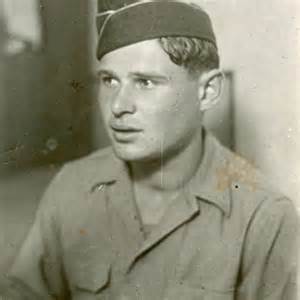
This is a picture of Paul Argiewicz used by the Wisconsin Veterans Museum but with no description. Considering he’s wearing a US Army cap it has to be from after 1950, which would make him over 25 years of age.
Remember Paul Argiewicz? He’s the guy I wrote about here because it’s widely claimed he’s in the Famous Buchenwald Liberation Photo, which he is not. But there are a lot of things wrong with the Paul Argiewicz story – claiming he is in that photo is just one of them.
Christine Miller has observed that being forced to believe holocaust survivor’s stories has made Western man irrational. Paul’s story is as irrational as any, especially when it comes to the simple act of adding together two-digit numbers. So let’s start there.
Paul’s date of birth is always given as Aug. 6, 1925 in Bielsko, Poland. He grew up using his mother’s name, Argiewicz, because his parents were not formally or officially married. The family included two older sisters. He told interviewers that he only went three and a half years to grade school. He was arrested in 1941 by his own reckoning, when he would have been 16 years old.
However, his story, wherever you look either online or in the book about him, states that he was age 11 at the time of his arrest by the Nazis, and in his own obituary written or approved by his family it says “he was arrested at age 10 by the SS for stealing bread for his starving family in the Jewish ghetto.” [The ‘stealing bread for starving family’ part is obviously fiction, but Paul was known as an emotional person who cried easily and liked to create as much sympathetic reaction in his listeners as possible.]
So what’s going on with this man? And with his family and biographer? Can’t they add? It’s apparent that holocaust survivors have become so complacent because of their experience that anything they say will pass that they actually believe “anything will pass.” Even to the point that if you’re born in 1925 you can be 11 years old in 1941. Think about it. The year of Paul’s arrest is not always mentioned as it is here, but we all know the camps were liberated in 1945, and we know he turned 20 in that year. Precisely, he was 19 on April 11, 1945, four months shy of his 20th birthday … not 14.
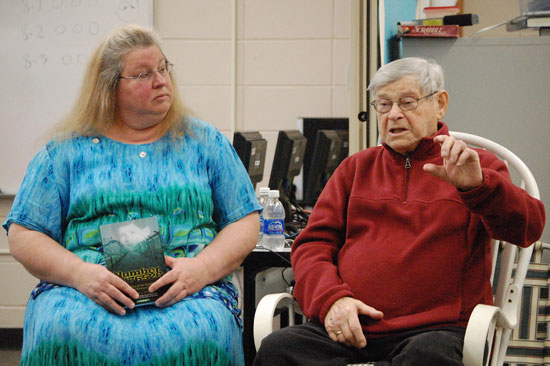
Deanne Joseph Ebner (left) who wrote the book “Number 176520: The Story of Paul Argiewicz ”A Teenage Holocaust Survivor” appeared with Argiewicz in 2012 at Riverview School.
What makes this age imposture important enough for Paul and his biographer to try to slip it past most readers? The craving for attention. Paul separates himself from the crowded field of fellow “survivors” by billing himself as a “child survivor.” He describes himself as being still a teenager when he was released … which he was, even if just barely. But he wanted to be younger still … a child. And what is surprising is that he basically has gotten away with it! I have not come across anyone questioning the claim that Paul was 11 when he was arrested, even though he was born in 1925. [I notice he told the Wisconsin Veterans Museum interviewer on page 7 that he was born in 1933!]
This type of “pass” can be better understood from a question by a poster commenting to another “survivor” who claimed he rode in a packed train car for 6 days with no food or water and no stops:
Did anyone die midway in the six day train ride with no food/water? I’m by no means doubting, just asking a question. As someone has mentioned below, you CAN survive without water for about a week.
God forbid these young people should doubt anything said by a holy survivor, no matter how unconnected to reality. The “survivor” answered he didn’t recall any deaths. But the point being, we don’t ask questions – we’re ashamed or afraid to question – and it leads to utter nonsense.
After doing more than a bit of research into Paul Argiewicz, I’ve come to the conclusion that there is also a felt need by him to gain as much sympathy as possible from being a tender 11 years of age to avoid what may be legitimate questions about what he actually did during that 4-5 years in German camps. I’m quite sure that Paul was never starved nor even mistreated during his time in the camps. He was more likely quite the collaborator. The photo on his German drivers license dated June 1946, only one year after liberation, shows a healthy young man with no sign of having endured any trauma whatsoever. He’s wearing an expensive leather jacket or coat and looks untroubled and at peace with himself.
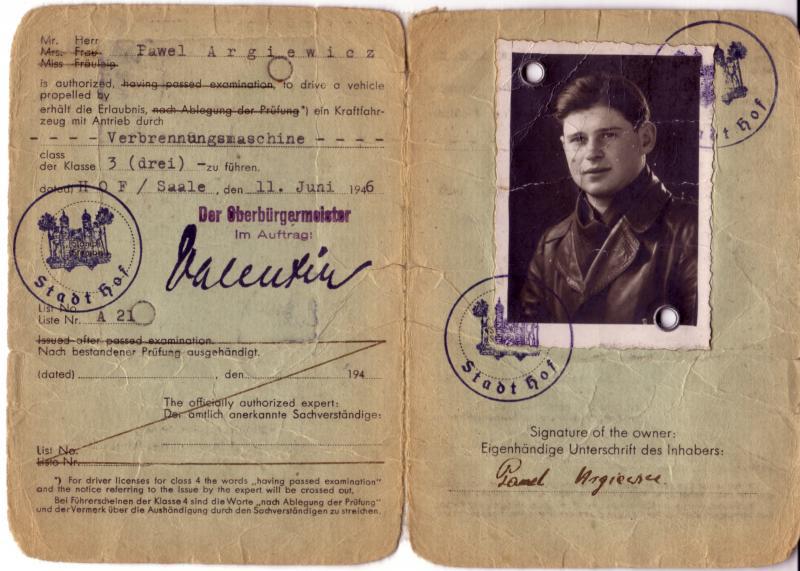
German Drivers License issued to Paul Angiewicz in June 1946. He was obviously living in Germany at the time and looking prosperous.
The same craving for attention also accounts for his willingness to falsely identify himself in the Famous Buchenwald Liberation Photo. Argiewicz named himself as the person 3rd from the left in the 3rd bunk up from the bottom in 2008, the same year his book came out. Everyone in that photo is self-identified, and it began after Elie Wiesel identified himself in it in 1983. Before that, no one was identified. After research by a number of people, including myself, it turns out the only correctly identified person is 16-year old Michael (Nikolaus) Grüner in the lower left. Even Argiewicz’ nephew, Murray Matzner, says his uncle is not in the picture, but excuses his uncle’s lies with the charge that he was under the influence of the woman who wrote the book about him, Deanne I. Joseph. Matzner wrote a comment at Scrapbookpages Blog in 2015 to a post that originally appeared in 2010.
It is obvious that my uncle Paul Argiewicz is not the person indicated in the photo. It looks nothing like him, and is in fact proved not to be him in his own memoir book photo on the opposite page where a drivers license photo one year later does not resemble this face at all. In particular, he did not have eyebrows that curved so far around his eyes.
The assertion that he is present in this photo was nonexistent until 2008, the year his memoir book was published. Since his ghost written book gets so very many facts and stories wrong, as the website associated with book sales also does, and stains a courageous man of integrity who is greatly missed because he is no longer with us, it appears that the false assertion is associated with the factually compromised book.
I have also seen a photo where it is the man one bunk lower, and to the left, a sleeping man facing away from the camera, who is indicated as my uncle with a vertical arrow.
I don’t know what it is with this photo. The individual indicated as Mr. Wiesel appears to have a receding hairline although a published image of him at age 15 prior to deportation does not have such a hairline. I believe that neither he or my uncle appear in the photo, and it appears to me that at least in the case of my uncle, that it was someone else pushing for him to be present.
My uncle was a wonderful, warm, caring, courageous, person who inspired so many with his exceptional love of life and people… but he isn’t in this photograph.
RIP, uncle. Your love lives on.
Comment by Murray Matzner — April 3, 2015 @ 1:03 pm
Okay Murray, except that Paul was photographed at one of his gatherings holding an enlargement of the famous photograph, indicating that he certainly wanted people to believe that he was in the picture. He, and maybe more so his wife Sheryl have been fully engaged in that fantasy.
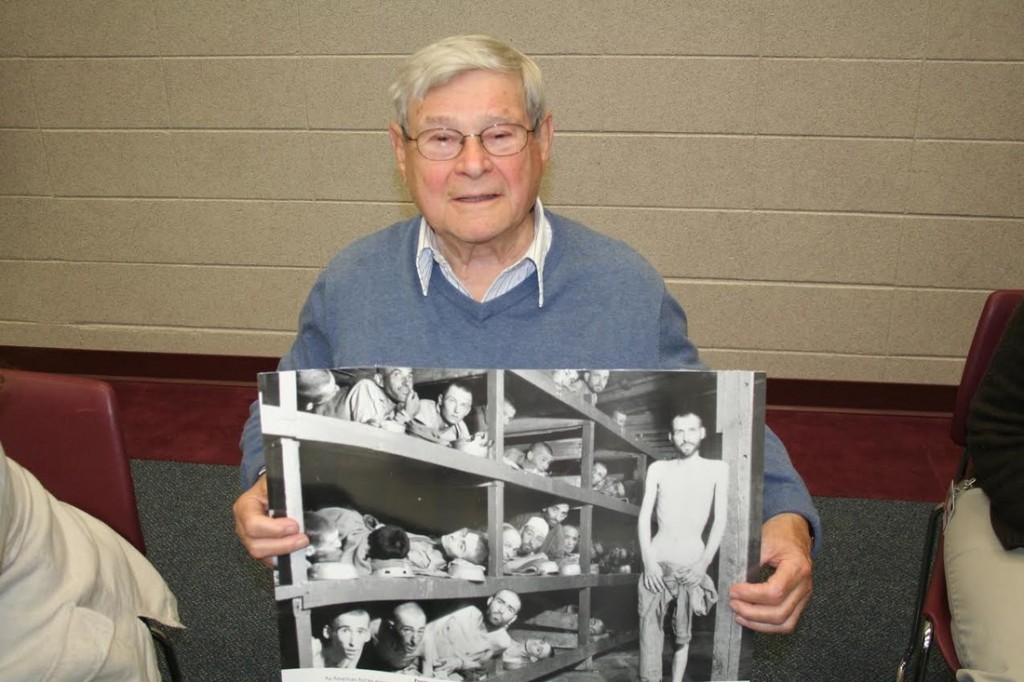
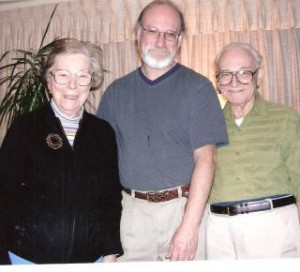
Lucy Argiewicz Matzner (Paul’s “beloved” sister), her son Murray and husband Robert.
Murray’s father, Robert Matzner, (left, in green shirt) who married Paul’s sister Lucy, was born in 1926 in the same Polish town of Bielsko. He has written his own holocaust memoir, titled Prisoner 19053. I wonder how many falsehoods that book contains? Hopefully not as many as Paul’s. But I think Murray may be trying to keep peace in the family by blaming the falsehoods in Paul’s book on the author. Clearly, Paul’s wife Sheryl had a lot to do with the writing of the book, and the three are often pictured attending book-promotion meetings together.
* * *
After Paul’s death in December 2013, some controversy broke out on the Amazon book advertisement page among the “reviewers.” Specifically “BTI” wrote:
In Memory of Paul
By BTI on June 22, 2015
Every story in this book is documented in numerous recordings, CDs, and videos as coming from Paul Argiewicz himself – his face, his words, his voice. It is Paul’s account of what happened to him as a young boy in the Nazi concentration camps. Anyone who knew Paul, loved Paul, was inspired by Paul, and truly desires to protect the memory of Paul Argiewicz will boldly stand witness against the frauds of the world (be they Holocaust deniers, anti-Semites, or vindictive relatives). All of the above-mentioned records of Paul’s testimony will soon be posted online. Be watching. May the evil ones be silenced by their own arrogance.
Cindy Nicoletti, Paul’s stepdaughter, posted a “review” by Dave Kasiske. In it he revealed:
“I am blown away that Paul’s nephew would come out now after Paul’s death. He cannot say the man in the picture is not Paul because the poor young Paul was probably close to death after experiencing starvation. Paul would say “Dave”, I can’t explain it to you how it was to cry at night because of starvation and never seeing my loved ones again.”
And
“Paul was always in tears when he told the story of his sister Lucy. Lucy is the mother of “Murray”, the one who is attacking Paul’s story. That brings the question to my mind, why would anyone who is Jewish go on a antisemitic spur? Even when I would sit with Paul at his kitchen table, the tears would flow when he talked about Lucy. Anyone who has the guts to attack a family member who survived the horrors of the Holocaust should seek psychological help.”
Yes, it takes guts indeed to stand up against holocaust lies, Dave. Maybe someday you’ll be able to do it. But now take a look at this from stepdaughter Cindy to see who is pushing Paul’s false story.
The owner of Sunless Expressions would like to recommend her stepfather’s book:
Number 176520
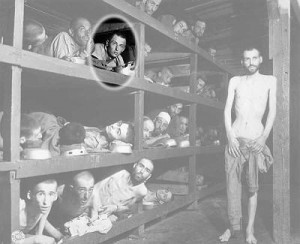
This famous photograph was taken a few days after the liberation of Buchenwald and appeared on the cover of a popular national magazine in the 1960s. Paul is pictured (circled) here on the third bunk from the bottom, the third person from the left (with his food bowl that doubled as a pillow).
Cindy, Owner and Founder of Sunless Expressions is the step daughter of a man with an astounding and miraculous life story. Paul Argiewicz was an eleven year old child in 1941 when he was arrested in Poland by two Nazi SS officers. His crime? Paul had stolen two loaves of bread to take to his starving family in the Jewish ghetto. Separated from his family and everything he loved, he would spend the next four years of his young life working as a slave laborer in seven different concentration camps. From Auschwitz to Blechhammer, Gross Rosen, and Buchenwald, Argiewicz; defied all odds by surviving one of modern history’s most unimaginable atrocities against humanity: the Holocaust.
Sunless Expressions is proud to recommend Number 176520 ~ The Story of Paul Argiewicz, a Teenage Holocaust Survivor. With over 16 pages of full-color photos, original camp documents, and other visuals, Number 176520 has quickly become a highly revered and sought-after Holocaust resource in schools, bookstores, libraries, museums, and homes. Visit www.paulsstory.com to purchase and/or learn more about the book that has been inspiring countless readers around the world.
We regretfully announce Paul passed away December 11, 2013.
Paul’s last public appearance before his death was on April 29, 2013 at the U.S. Holocaust Museum’s 20th Anniversary Ceremony with speakers Elie Wiesel and Bill Clinton. Here he is photographed with his wife Sheryl and grandson Jordan, who are active in furthering the mythical version of his life. In another photo he is showing off his Auschwitz tattoo “176520,” as they were all doing that night (except for Wiesel, of course). Yes, they were there, but what they did or did not experience cannot be proven by a tattoo.
There are no excerpts available from his book at Amazon, but I found this one and am going to quote it in full here. It gives a good idea of the fictional style found in most holocaust survivor stories – no dates, times, names – the events, as they are, exist as if floating in space, but are meant to evoke as much emotional sympathy, shock and pity as possible toward the subject. Notice the similarities to Elie Wiesel’s Night, which must have been used as a model, for example when the fellow arrestee advises a confused Paul to say he is 18. However, Paul’s “ghostwriter” handled the impossible jump from age 11 to age 18 by having the SS man play it as a sort of joke. And since Paul says he spoke perfect German, that warmed the heart of the otherwise cold officer. The whole scene is a lie …
At Scrapbookpages Blog, the blogger wrote in March 2010: “Argiewicz says that he had an advantage because he could speak fluent German since his mother was from Bavaria, a state in Germany.” Of course, we know his mother and father were both Polish, and Ms. Joseph comes up with a different story: That Paul associated with Gentile youths when he snuck out of the ghetto every other night for a year (!) and learned German that way. But weren’t there Poles along with Germans outside of the ghetto? This is not explained, of course, but left to your imagination. Apparently a German baker and his children just loved little Paul and gave him bread and German lessons too.
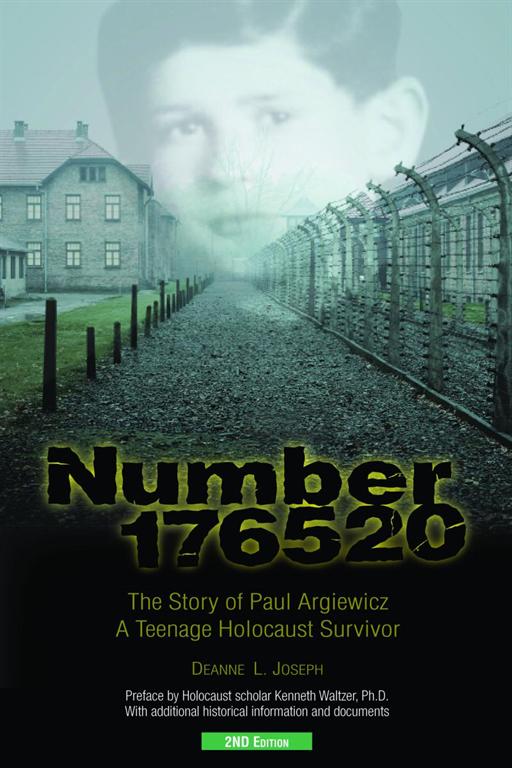
Look how dishonest the book cover is. Paul was not a young child in the camps but 16 to 19 years old. He wasn’t even in Auschwitz except for 2 days, then, according to him, sent to Blechhammer, and spent the last 4 months at Buchenwald.
The preface to the book is written by our old friend, Professor Kenneth Waltzer, and in it he gives “historical documentation.” I would really like to see that. I should order the book and write more about this later; the only thing that stops me is that you and I both know there is no end to this stuff. One thing leads to another. So we’ll see, but for now, enjoy this excerpt. You will notice that not a single person has a name except Paul.
* * *
Deanne L. Joseph’s moving new memoir, Number 176520 –The Story of Paul Argiewicz, a Teenage Holocaust Survivor, poignantly recounts one child’s journey through the terrors. With a preface and historical documentation provided by renowned Holocaust scholar, Professor Kenneth Waltzer (Director of Jewish Studies, Michigan State University), Number 176520 is quickly becoming an invaluable resource for students of the Holocaust.
Following is an excerpt from the book:
Paul and his family lived in the ghetto for about a year. In spite of the dire circumstances, his boyish, adventurous nature remained. He removed the identification patch from his clothing and sneaked out of the ghetto [Sosnowiec, not Warsaw -cy] through an opening in the barbed wire fence. It was an act of defiance that would have landed him at the end of an executioner’s gun had he been caught, but somehow he was able to pull off this rite two to three times a week. [I don’t think an 11-year old boy would be allowed out alone at night by his loving parents, do you? Neither would he have been shot dead if caught.-cy]
Being the gregarious child that he was, he made friends with some gentile children on the “outside.” They did not seem to mind that he was Jewish, and some of their parents even tried to help him in small ways. The father of one of his new friends owned a bakery. The man’s sympathetic conscience obliged him to turn a blind eye, allowing Paul to steal freshly baked bread from his store twice a week. The ritual continued for a year. Sometimes the determined young scavenger managed to find potato peels or other small provisions of vegetables and was always faithful to rush his smuggled goods back to his hungry family behind the fence.
Eventually, Paul became so comfortable in his excursions that he inadvertently lowered his guard and came face to face with disaster. Returning to his family with a pair of stolen loaves of bread, he was approached by two SS officers.
“Where did you get that bread?” they demanded. Paul had never been so close to the enemy. He stood, accused and frozen.
“Come with us!” The order was stern and curt. They snatched the bread from his hands. The pounding of his heart intensified until he thought it would surely break through his chest. He could barely breathe. He felt a hard, squeezing pressure on his arm — the grip of a Nazi. He had the sensation of walking very quickly, although he was unable to feel his legs. Were his feet touching the ground? Were they even moving? He heard only the sound of the officers’ boots clacking with each step on the hard street beneath their feet. His eyes burned as if on fire, and blurred images of his family flashed through his rattled brain. What would they think? Would he ever see them again? Were these men going to kill him? Paul fought to restrain the tears pooling in his eyes. He was only a child — his life was supposed to be ahead of him, not behind.
They arrived at their destination: an old schoolhouse that had been converted into a transitory evaluation and detainment center, the Durkankslager. He was taken downstairs to the basement, the “dungeon.” It was filled with people standing in lines. Everywhere were the familiar Jewish identification patches. The Nazis pushed him into place with the others. He looked around at the detainees, predominantly grown men. He did not see any other children in the crowded space.
An SS officer sat upright on a stool at the front of the room, one leg raised and bent at the knee with his booted foot confidently perched on a table. Behind him was a desk filled with papers. As each of the accused men made his way to the front of the line, he was questioned by the man on the stool, evaluated, and sent into a group either to the right or to the left. Paul was not sure why the men were being divided, but as he drew closer to the evaluating officer, he was overcome with a sense of doom. His mind fired rapid, disconnected thoughts. I’m only a child . . . perhaps if I tell them I’m only 11 years old . . . maybe they will have pity and let me go back to my parents.
Without warning, a man behind him in the line kicked the back of his leg. He leaned into Paul’s ear and spoke quietly but firmly.
“Don’t tell them your real age. Tell them you’re 18.”
How did he know what I was thinking? Paul wondered.
He arrived at the head of the line. No longer did anyone stand between him and the “judge.”
“Name?” “Paul Argiewicz.”“Age?” “Eighteen.”
The words rolled off his lips in perfect Bavarian German. The officer looked up. His dusky eyes examined the youth before him. His brow furrowed, and he observed the boy for a moment. Paul felt as though he had been suspended in space and time. The moment seemed to last an eternity. Surely, he was exposed . . . guilty . . . he had lied . . . to an SS officer! The penalty for such an offense was execution.
“You speak German?” The officer seemed amused. “Yes,” he responded once more in the language he had learned from his playmates.
“You speak with a Bavarian accent. Why?” “My mother is from Bavaria,” he lied again. For another endless moment, the man’s eyes pierced him. Paul was able to manage a convincing expression. Finally, the harshness of the Nazi’s sharply featured face faded, yielding to a smile and a chuckle.
“Go over there,” he said, nodding his head to his left.
Paul moved in the direction of the nod, but he did not understand the purpose of separating the men. Would he be sent to work or to the grave? None of the men seemed to know the fate that awaited them.
They remained in the detainment center for a few more days. Each day they were given small rations of bread and a cup of water. Paul allowed his mind to escape into a place of refuge and peace. He comforted himself with thoughts of his family, memories of good times they had shared, life in Phella’s beautiful home, and the hope that maybe he would soon be returning there.
In the corner of his eye, Paul perceived movement through a window in the damp stone wall. He turned his head to look through the dusty glass. Just beyond the tall barbed-wire fence, his father stood, his eyes scouring the room through the wire and glass. Noah’s eyes found Paul’s. His hand flew over his head waving to his son, his familiar penetrating eyes filled with longing. He held his hand still for a moment and then let it fall limp to his side. He stood motionless, his gaze fixed on his child. [This is a totally fictional account intended to create poignancy. Paul never saw his father through a window.]
Paul’s heart raced within him. An overwhelming urge demanded that he jump to his feet and run to the window. He dared not. To do so would jeopardize not only his fate but also now his father’s. Separated by brick and mortar, barbed wire and guns, and the merciless cruelty of the human heart, father and son looked upon each other for the last time. In that sacred moment, they knew that the bond they shared was beyond man’s reach; it was a bond protected and preserved in eternity. Still, the 11-year-old was overcome by the realization that he might never again feel the loving touch of his father’s strong hands or hear the sound of his voice.
On the cold, hard floor, Paul covered his face and wept. His father was gone. [End of excerpt]
5 Comments
Category Featured | Tags: Tags: Auschwitz tattoos, famous Buchenwald photo, Holocaust fraud, Ken Waltzer, Murray Matzner, USHMM,
Social Networks: Facebook, Twitter, Google Bookmarks, del.icio.us, StumbleUpon, Digg, Reddit, Posterous.
Wednesday, December 23rd, 2015
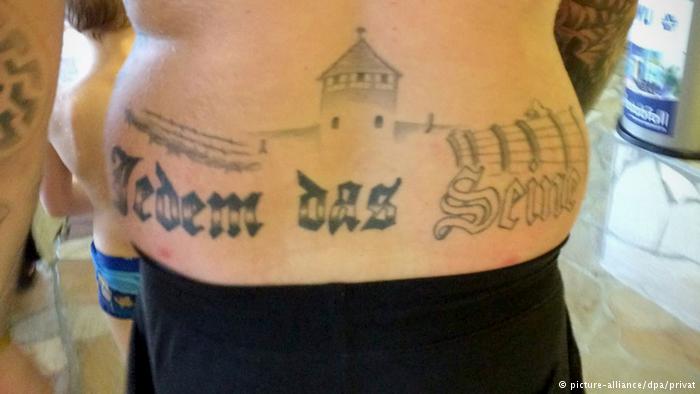
This is the tattoo that, if seen by the public, will incite hatred for Jews, according to prosecutors and courts in Brandenburg, Germany. But why wouldn’t it incite sympathy just as well?
By Carolyn Yeager
In a Berlin court, a German man is convicted for having a tattoo resembling a concentration camp entrance on his body.
Why then is Elie Wiesel not convicted in Germany for not having a concentration camp tattoo on his body, but saying he does?
Wiesel was in Germany at least three times impersonating a “nazi” concentration camp survivor. His first visit was in June 1986 when he spoke in Loccum, West Germany as the author of the book Night, which he claims to be a record of his own experience. In Night, the main character is tattooed with the number A7713 on his left forearm, which Elie claimed under oath in California is still there on his arm. Apparently, no one in Loccum asked to see it.
He returned the next year in November 1987 and spoke in a modern conference center inside the shell of the destroyed Reichstag. The title of his talk was “Reflections of a Survivor” in which he, as in the prior year, couldn’t keep from speaking words of blame toward the German people.
On June 5, 2009 he was at the Buchenwald Memorial outside of Weimar, accompanying the President of the United States and the Chancellor of Germany in the guise of a former resident of the camp. I know this for sure because I was in Dresden on this very day and watched it on German television.
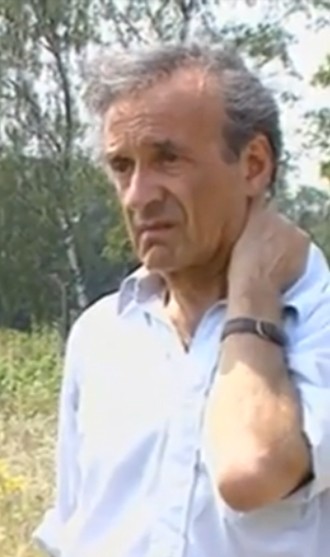
Elie Wiesel’s left arm in bright sunlight, taken from his video “Elie Wiesel Goes Home”
Elie Wiesel’s main authentication for being interned at both Auschwitz/Birkenau/Monowitz and at Buchenwald is the tattoo A7713 which matches records for a Lazar Wiesel from Sighet. Elie says he has it on his arm but he has never allowed the public to see it! He does not confirm his claim by showing his forearm, as do so many survivors – the very survivors he claims to be one with.
Yet on some occasions he’s been photographed with short sleeves and there is no tattoo visible on either of his arms. This is absolutely incredible, right? That the world’s most famous holocaust survivor is in truth “the emperor wearing no clothes” … the “elephant in the living room.” The world media say nothing because they can’t—they pretend not to notice and hope you do the same.
To get to the point
But why is Marcel Zech, a 27-year old town council member representing the National Democratic Party (NPD) dragged into court and convicted of sedition and inciting hatred because of a tattoo on his lower back that no one would normally see anyway … while Elie Wiesel comes to Germany at age 57, 58 and 81, and with great publicity misrepresents himself as an Auschwitz and Buchenwald concentration camp survivor with the tattoo A7713 on his arm that he doesn’t have, and the German Justice system doesn’t even notice.
I demand that German prosecutors investigate Wiesel’s claim to have a tattoo, and bring charges against him when they find he doesn’t have one, never did have one—charges of defrauding the public and of inciting hatred against Germans as a people.
Let’s take a look at the “crime” of Marcel Zech. According to the photo taken at a pool party, Zech’s tattoo (see image above) is the likeness of a structure that resembles the entrance to the former Birkenau Camp in Poland but there is no name identifying it as such. Under the image are the words Jedem das Seine in large gothic-style letters. Jedem das Seine translates as “To each his own” and was on the gate of the Buchenwald camp entrance, not at Auschwitz or Birkenau. So what is the connection, what is the message?
I would say there is no message since the image and the phrase don’t go together in the “holocaustian” sense. Is it illegal in Germany to use the words Jedem das Seine? Can’t be.1 Is it illegal in Germany to post or publish an image of the entrance to Birkenau? No, because it’s done all the time, especially by Jews. So what is the problem with Marcel’s tattoo?
The problem is that he is an office-holding member of the NPD, which the federal government in Germany is currently trying to ban. Yes, ban it as a political party. It has been a German political party since 1964!
On the other hand, Elie Wiesel is a Jew, and Jews are never investigated for anything in Germany, let alone found guilty of something. Have you ever heard of it? I did an internet search and came up with nothing.
State prosecutors had demanded that the accused [Zech] be sentenced to 10 months in jail without parole because, according to DW, he seemed to be “a politically motivated criminal, who had trampled on the core values of the German constitution.” What are the “core values” of the German constitution?
Consulting the German Basic Law (constitutional law), I come up with a few:
Art. 3: No person shall be favored or disfavored because of […] political opinions.
Art. 4: … freedom to profess a religious or philosophical creed, shall be inviolable.
Art. 5: Every person shall have the right freely to express and disseminate his opinions in speech, writing, and pictures.
But then there is also Article 139 [Continuing validity of denazification provisions]:
The legal provisions enacted for the “Liberation of the German People from National Socialism and Militarism” shall not be affected by the provisions of this Basic Law.
Get that?–The German people were liberated. At least we know that Germany is still functioning under the 1945 Military Control Council of Supreme Commander Dwight Eisenhower. Not much progress there.
But back to Elie Wiesel: What is the law against impersonating a concentration camp survivor? It appears there is none. While it’s a crime to minimize the “Holocaust”, it’s perfectly okay to maximize it. Lying about the Holocaust by adding to the narrative is fine; just don’t take anything away from it. Not when you’re in Germany.
[By the way, the Deutsche Welle story repeated a falsehood from a previous story when it said that Buchenwald was “the Nazi regime’s largest death camp.” Buchenwald is not considered to be a “death camp” even by holocaustian historians. Martin Schultz was using the occasion of a 70th anniversary to advise that because of Buchenwald, Germans were obligated to welcome refugees.]
Endnotes
1. From Dictionary.com: One has a right to one’s personal preferences, as in I’d never pick that color, but to each his own . Versions of this maxim appeared in the late 1500s but the modern wording was first recorded in 1713.
Sunday, December 28th, 2014
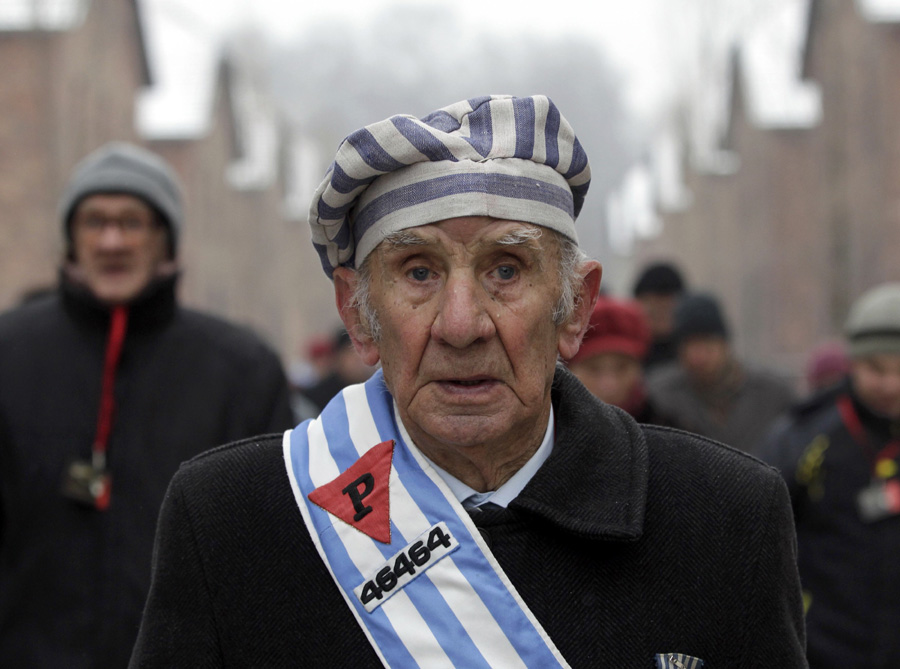
Have we had enough of this theater yet? Do “holocaust” images like this have any effect on our sympathies? This is a well-aged, healthy looking “survivor” at the 69th Anniversary of the Auschwitz liberation on Remembrance Day, Jan. 27, 2014
___________________________________________________________
By Carolyn Yeager
Wiesel: “I thought the memory of the Holocaust would shame those boasting anti-Semitic opinions. I was wrong.” … Jan. 28, 2014
It becomes more clear all the time that the massive goodwill that Jews and “Israel” gained from the propaganda hoax they named “The Holocaust” has been depleted, due in large measure to Israel’s uncivilized aggressive behavior against its neighbors in the Middle East.
But another major reason for the loss of goodwill is Israel’s and world Jewish organizations’ insatiable lust for ever more money and arms from Germany, the U.S. and all of Europe and North America. The Jews have played the phony guilt card for all it’s worth, and for a long time now (70 years!) – and it is finally wearing out. When Jews tell us that grandchildren of “survivors” are carriers of their grandparents’ “trauma,” that becomes the straw that breaks the camel’s back.
Both Elie Wiesel and Caroline Glick have made statements in 2014 referring to the “Holocaust” as a way – a vehicle – to do away with “antisemitism,” i.e. dislike of Jews. They thought the combination of the horrific atrocity stories camp survivors were able to dream up, and the incredible number of 6 million, plus having the governments of America, Britain and the Soviet Union on their side would keep Germans and all European people making amends to them for a good long time – long enough, anyway, for Jewish billionaires to completely consolidate their ownership/control of everything of value in the Western world (just as it’s told in The Protocols of the Learned Elders of Zion).
But as it turns out, European men and women are more resilient than that. And then Jews, in their chutzpah, make plenty of mistakes, too. The end result, as we enter the year 2015, is that Jews, rather than feeling victorious, are crying and gnashing their teeth over “the rise of antisemitism in Europe.”
Is there a conspiracy going on?
Today, I went looking for what I remembered as Elie complaining about antisemitism in the same way that Caroline Glick does. I quickly came upon it, and it was from January 28, 2014, the exact same day that Glick’s blog post appeared! … the one I wrote about here. Coincidence?
They are both saying the same thing, each in their own way, on the day after the “International Holocaust Remembrance Day” on Jan. 27, which was not such a big success. The major news story it conjured up was that the Israeli Knesset sent a large delegation that marched around on Auschwitz memorial grounds with giant blue and white flags, while having their picture taken. Elie Wiesel did not show up, which took away some of the news-worthy luster of the 2014 event.
It’s interesting that Benjy Netanyahu was saying pretty much the same as Glick and Wiesel just recently:
“We saw today examples […] of European prejudice. In Geneva, they are calling for an investigation against Israel for war crimes, while in Luxembourg the European court removed Hamas from the terrorist list. It looks like there are too many people in Europe, on the [same] ground where six million Jews were slaughtered, who haven’t learned a thing. The friendship we see from the United States stands in complete contrast to what we are seeing regretfully in Europe.”
Recall that Caroline Glick once worked as an assistant to Netanyahu. She and Elie Wiesel are both long-time Israeli assets, so do they coordinate their message?
What exactly did Wiesel say in this interview of eleven months ago?
“The Holocaust is a unique event, but it has a universal significance which must be memorized incessantly.”
“Unfortunately, anti-Semitism still exists. It has been alive for more than 2,000 years, and will likely continue living. I thought that the memory of the Holocaust would shame those boasting anti-Semitic opinions. I was wrong. It still exists in different countries, and it seems people are no longer ashamed to be anti-Semitic.”
“The modern anti-Semite is, first and foremost, anti-Israel. It’s very difficult to separate between the two.” (Anti-Israelism and antisemitism)
“There are anti-Semites who are only anti-Israel. Once I thought that anti-Semitism had ended; today it is clear to me that it will probably never end. It might weaken sometimes, but it will continue existing, because in different countries there is no shame in being an anti-Semite. We must remember that anti-Semitism led to Auschwitz. Without anti-Semitism there would have been no Auschwitz.”
“It’s clear to me that one can’t be Jewish without Israel. Religious or non-religious, Zionist or non-Zionist, Ashkenazi or Sephardic — all these will not exist without Israel. The [Israeli] State’s existence is the oxygen of the image and ideas of the new anti-Semitism.“
“Recent attacks on Jews in the United States are expressions of anti-Semitism, yet we can’t talk about an anti-Semitic movement but about groups of anti-Semites which operate in different places, and we don’t know how many members they have. This reality must also concern us, because it could expand.”
The difference between Wiesel and Glick is that he did not say the Jan. 27th International Holocaust Remembrance Day made antisemitism worse, not better, but he DID rather dismiss it by saying that in the United States it is only marked with an event held at the UN building.
He agrees with Glick that the real American commemoration is on Yom haShoah, the same day as for the State of Israel. According to Yoel Rappel, the Israeli whom Wiesel appointed to be the director of his archive at Boston University, it was Wiesel who proposed this day to the American Congress when he was chairman of the President’s Commission on the Holocaust under President Carter. It has become a “fixed tradition” in the U.S., said Rappel. ~
4 Comments
Category Featured | Tags: Tags: anti-Semitism, Caroline Glick, Holocaust fraud, Holocaust Remembrance Day, Israel,
Social Networks: Facebook, Twitter, Google Bookmarks, del.icio.us, StumbleUpon, Digg, Reddit, Posterous.
Saturday, May 19th, 2012
by Carolyn Yeager
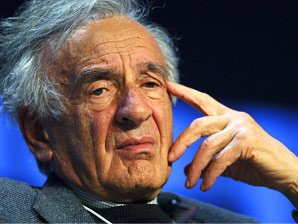
To cry or not to cry, that is the question.
Elie Wiesel, as usual, cannot make up his mind.
On May 6, he gave a major speech (for big bucks) at Xavier University in Cincinnati, brought there by the Center for Holocaust and Humanity Education. A reporter who covered the speech wrote that Wiesel said this:
Wiesel recounted his rescue from the concentration camp by the U.S. Army and said he remains grateful.
“We cried,” he recalled. “We discovered for the first time that we could cry.”
But in an interview that was published on the following day, May 7, on NBC New York, Wiesel said the opposite to reporter Gabe Pressman:
He told me about the day the American army came to liberate the prisoners,
How the prisoners “wanted to cry but they didn’t know how to cry… if you cry, you will never stop so they didn’t even do that.”
So which is it? Did they cry or didn’t they? It seems you get to choose which version you like best.
I pointed out in this article on the Xavier speech that this was the first time I had ever heard or read Elie Wiesel say that he or his barracks-mates cried. Since this Blog takes the position that Wiesel was not even there (in Buchenwald), it’s kind of a mute point–except for the fact that it’s one more reason not to believe he was there. He can’t keep his “story” about it straight.
Wiesel embellished his Buchenwald liberation tale when he was interviewed by Oprah Winfrey, too. As I recounted in this article, he told Oprah in Nov. 2000 that the first thing the religious boys in his barracks did was to “reassemble” and offer prayers for the dead–yet in his books he made a point to say the only thing anyone did was go after the food provisions. He wrote that they had no thought of their families nor of friends, only of food.
The flexibility of memory
Considering all this, we arrive at a crucial question about the Holocaust. The fate of nations may hang on it! What does it mean if Memory, that sacred human ability on which the entire holocaust narrative rests, cannot be depended upon?
Elie Wiesel’s memory is clearly not reliable. Yet he himself has made everything depend on memory. He wrote: “I shall never forget that night, the first night in camp […] never shall I forget those moments … ” and so on. But he must have forgotten some things since his story doesn’t remain consistent.
Memory itself–the act of remembrance–is just not what Elie Wiesel makes it out to be. For Weisel, it’s more like these words he is famous for saying: Some things are true though they didn’t happen, while others are not, even if they did. That is how we tend to remember!
In his case, Elie Wiesel was liberated from Buchenwald, even if he wasn’t … and it’s not true that the prisoners were only interested in food, even if they were. Memory–it’s such a flexible thing.
17 Comments
Category Featured | Tags: Tags: Buchenwald liberation, Elie Wiesel, Holocaust fraud, memory, Oprah Winfrey,
Social Networks: Facebook, Twitter, Google Bookmarks, del.icio.us, StumbleUpon, Digg, Reddit, Posterous.


 Of his several statements, covered in my article “Elie admits his true stories never happened,” I think the most compelling was in a 1970 interview with Gilles Laponge, published in the book Elie Wiesel: Conversations (2002). You can find the interview online HERE at Google Books. Wiesel said:
Of his several statements, covered in my article “Elie admits his true stories never happened,” I think the most compelling was in a 1970 interview with Gilles Laponge, published in the book Elie Wiesel: Conversations (2002). You can find the interview online HERE at Google Books. Wiesel said:





























